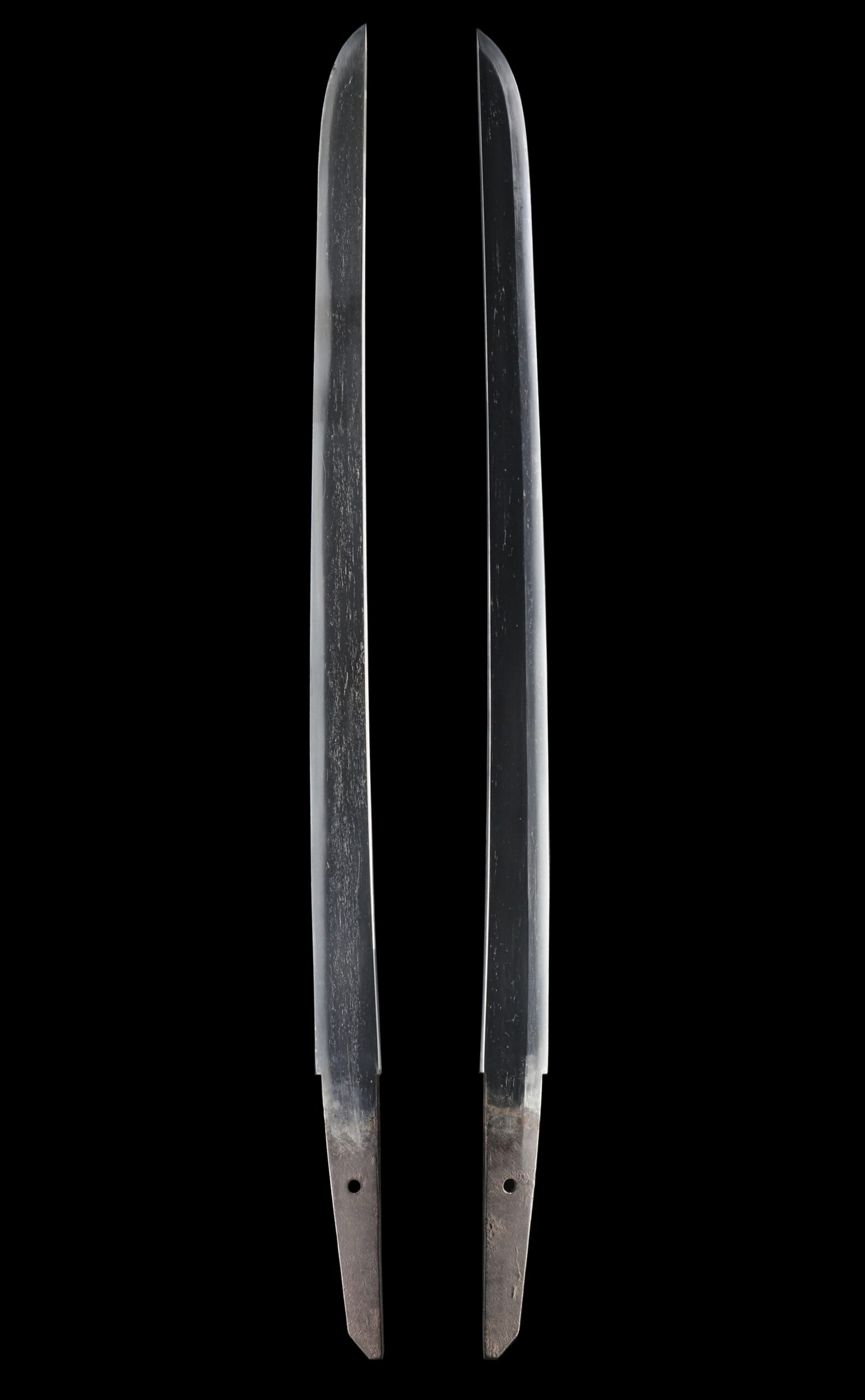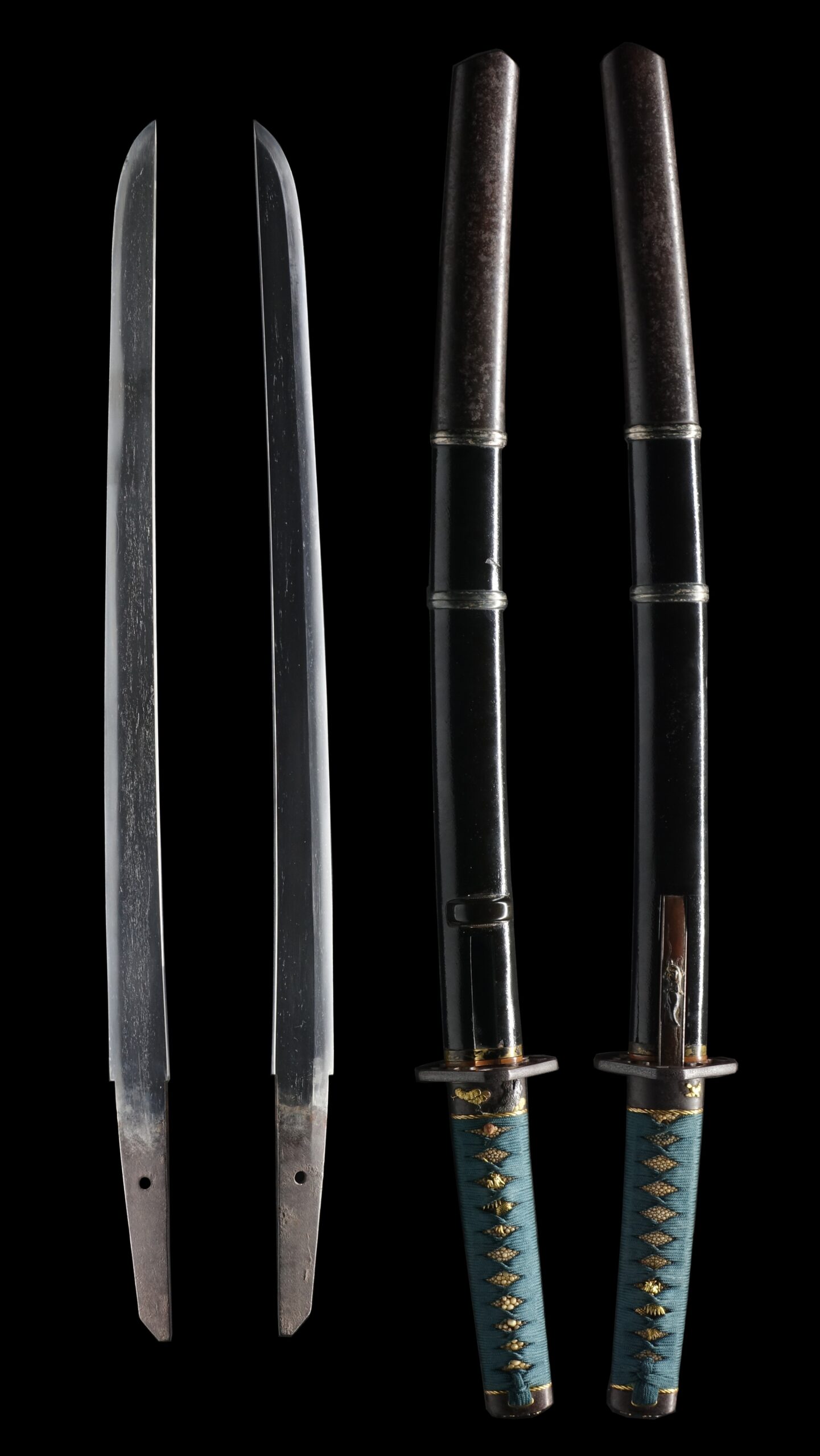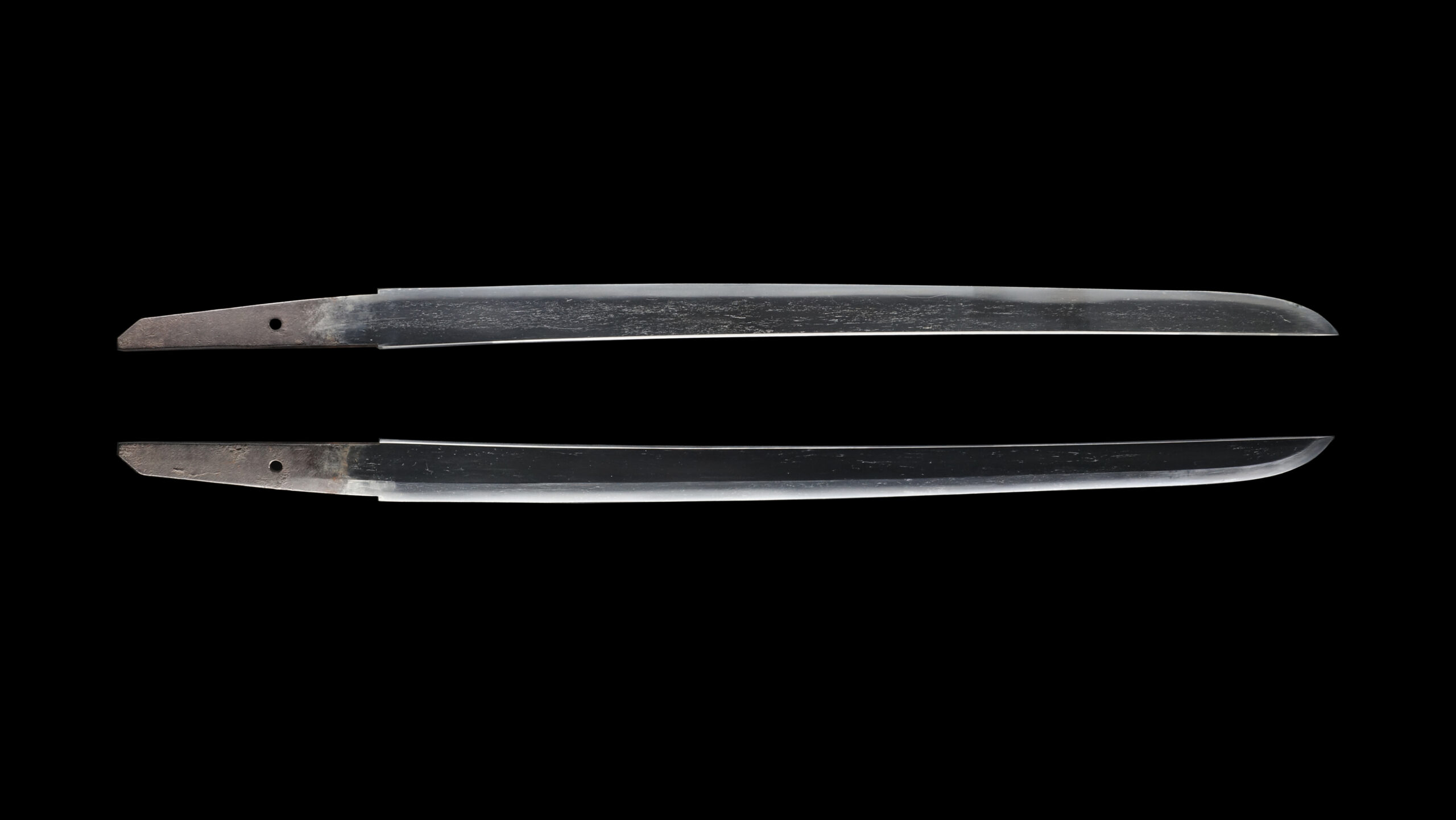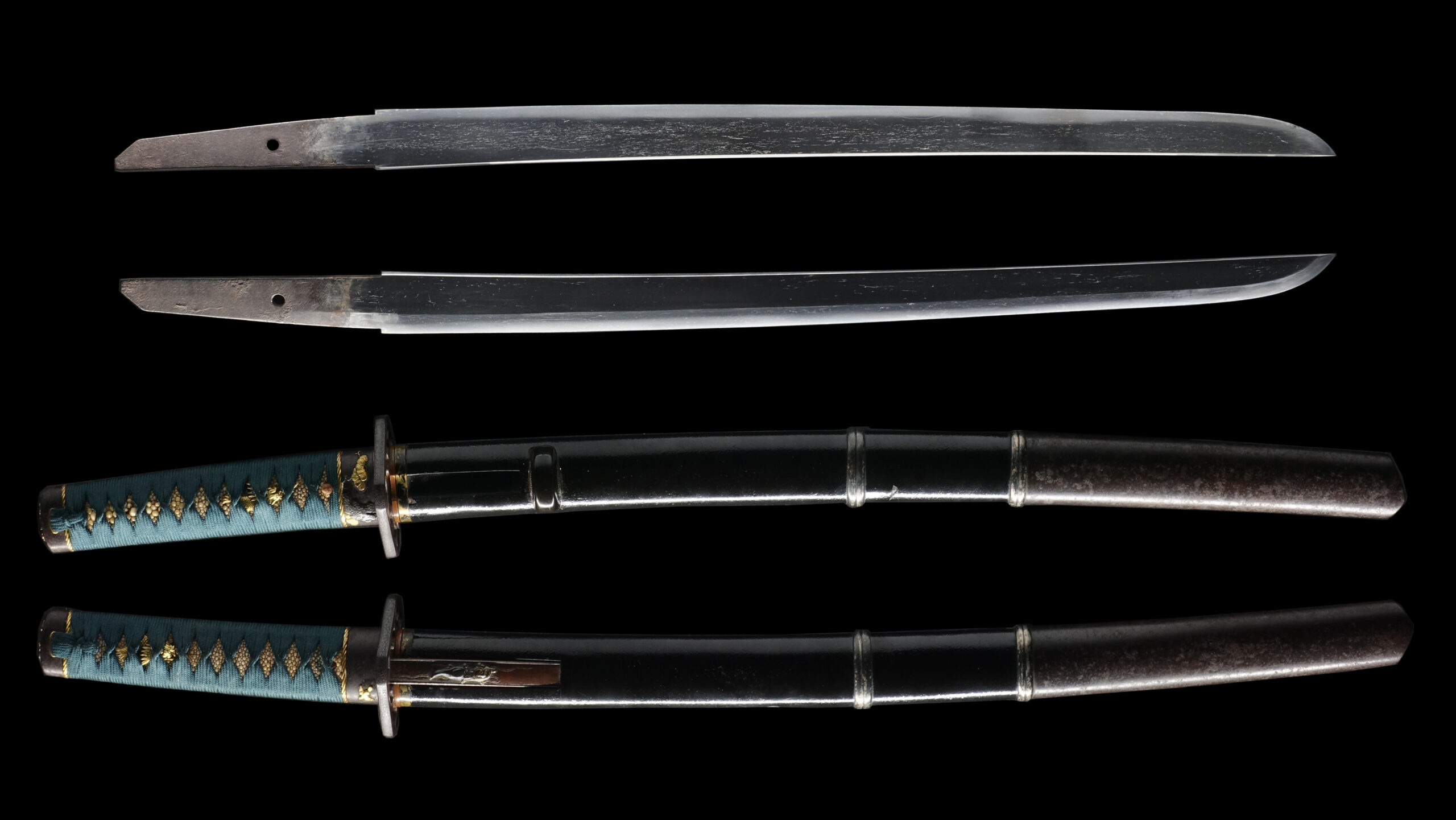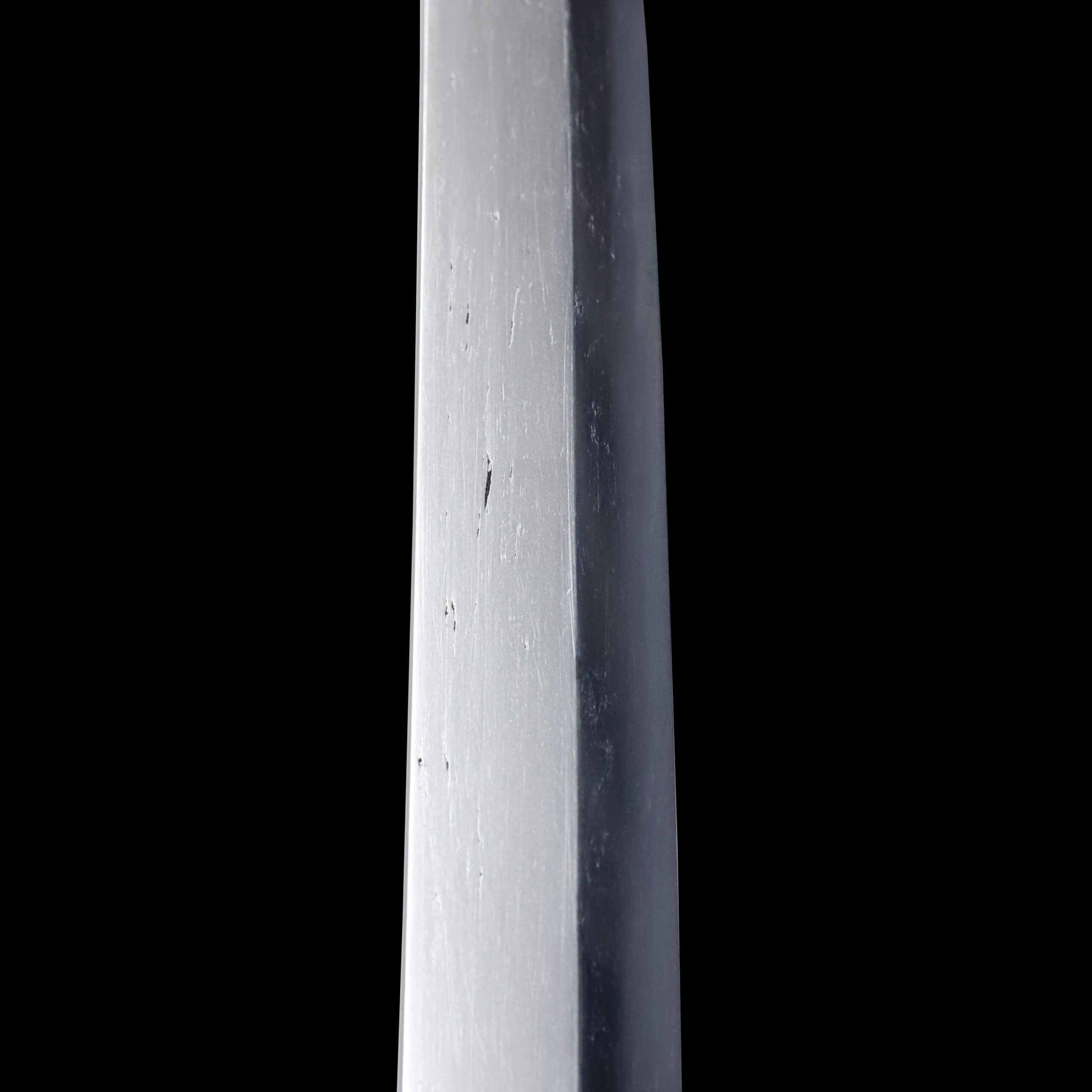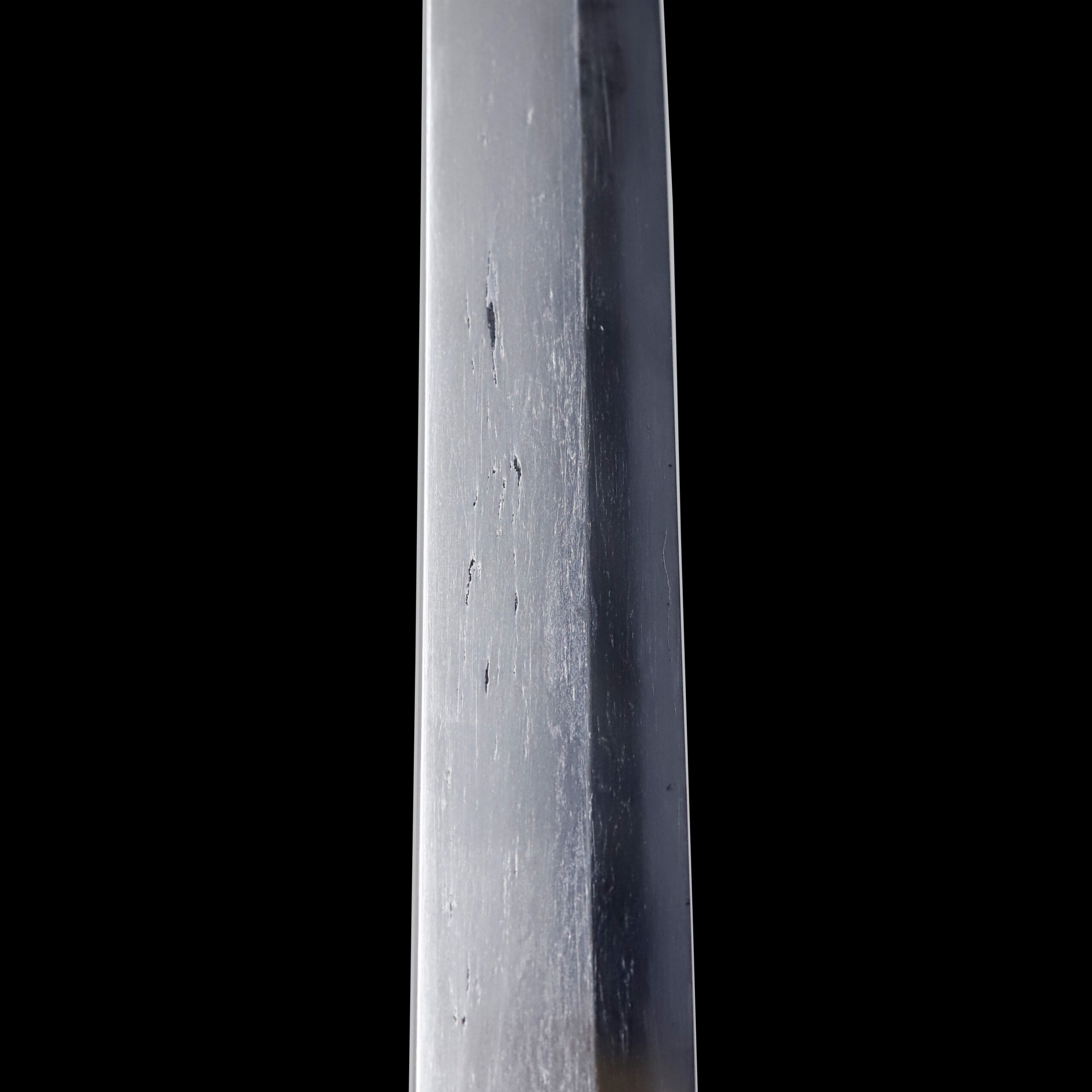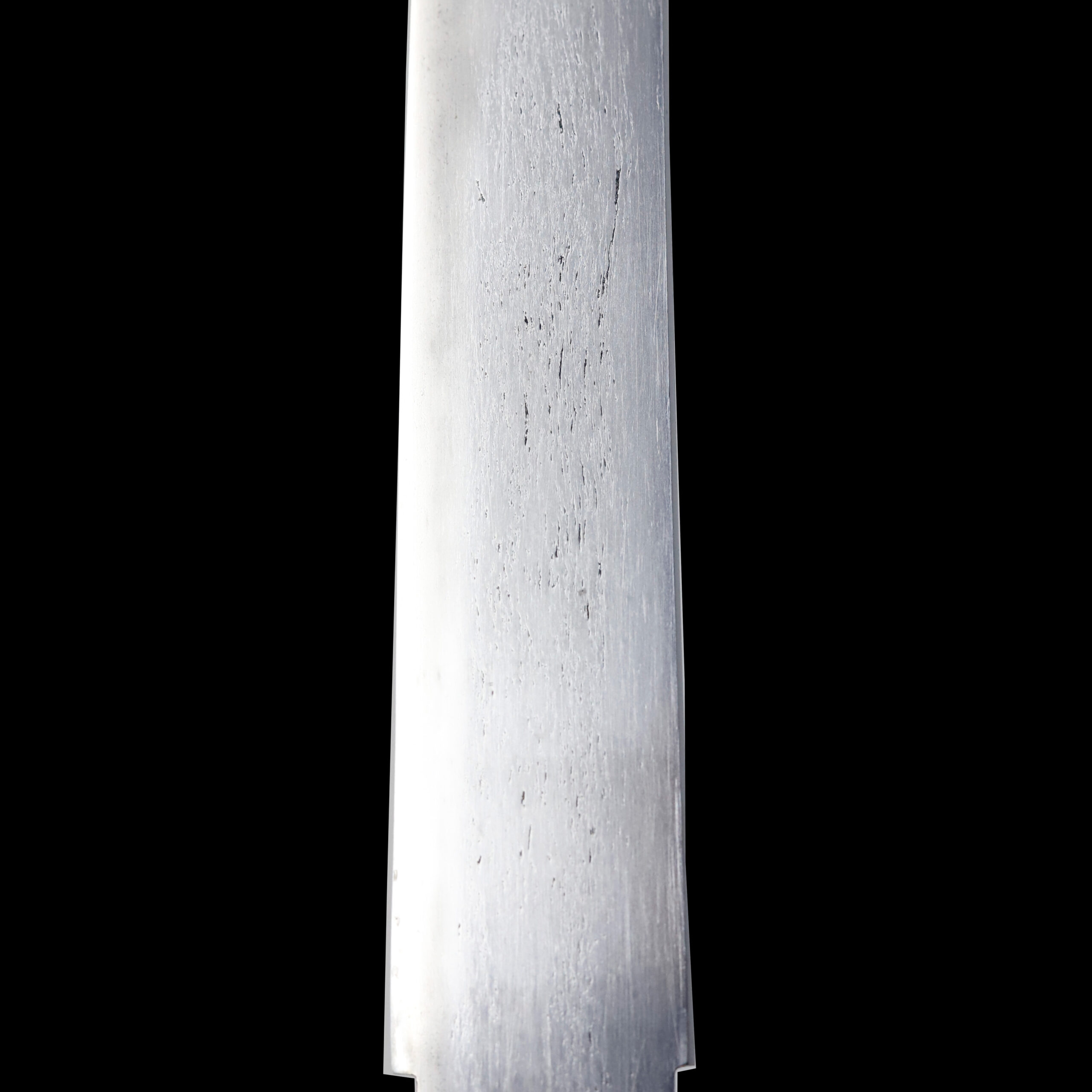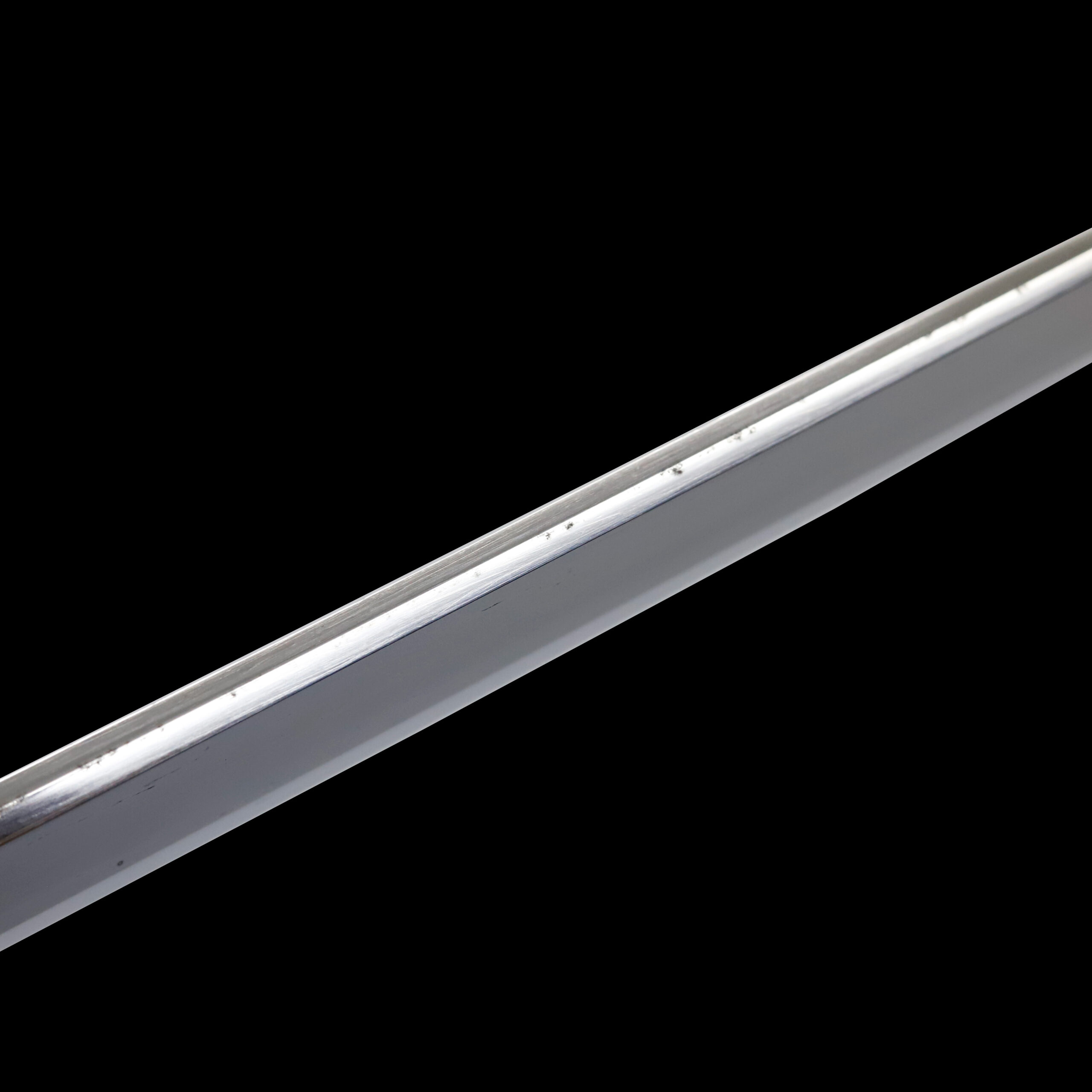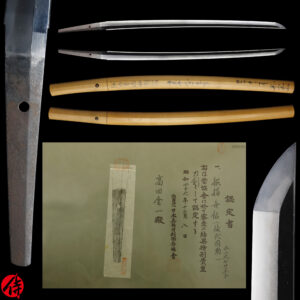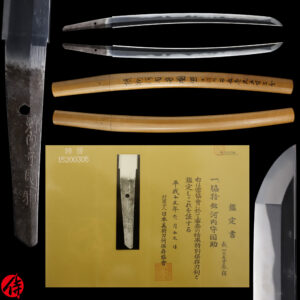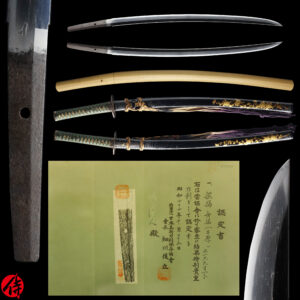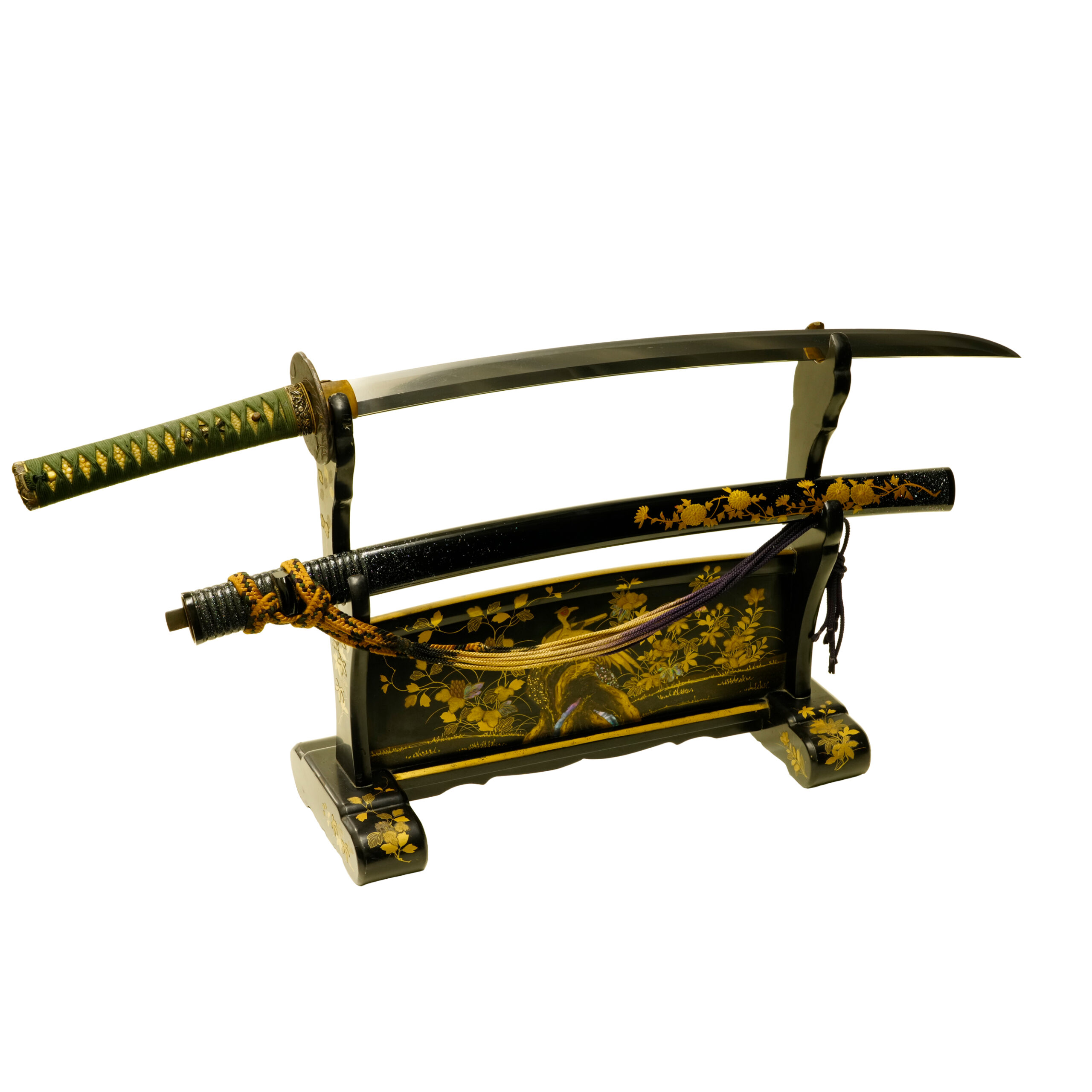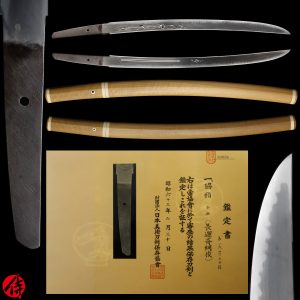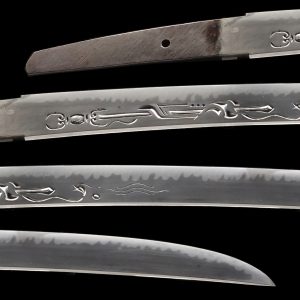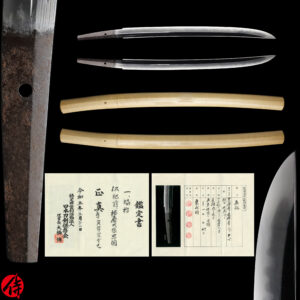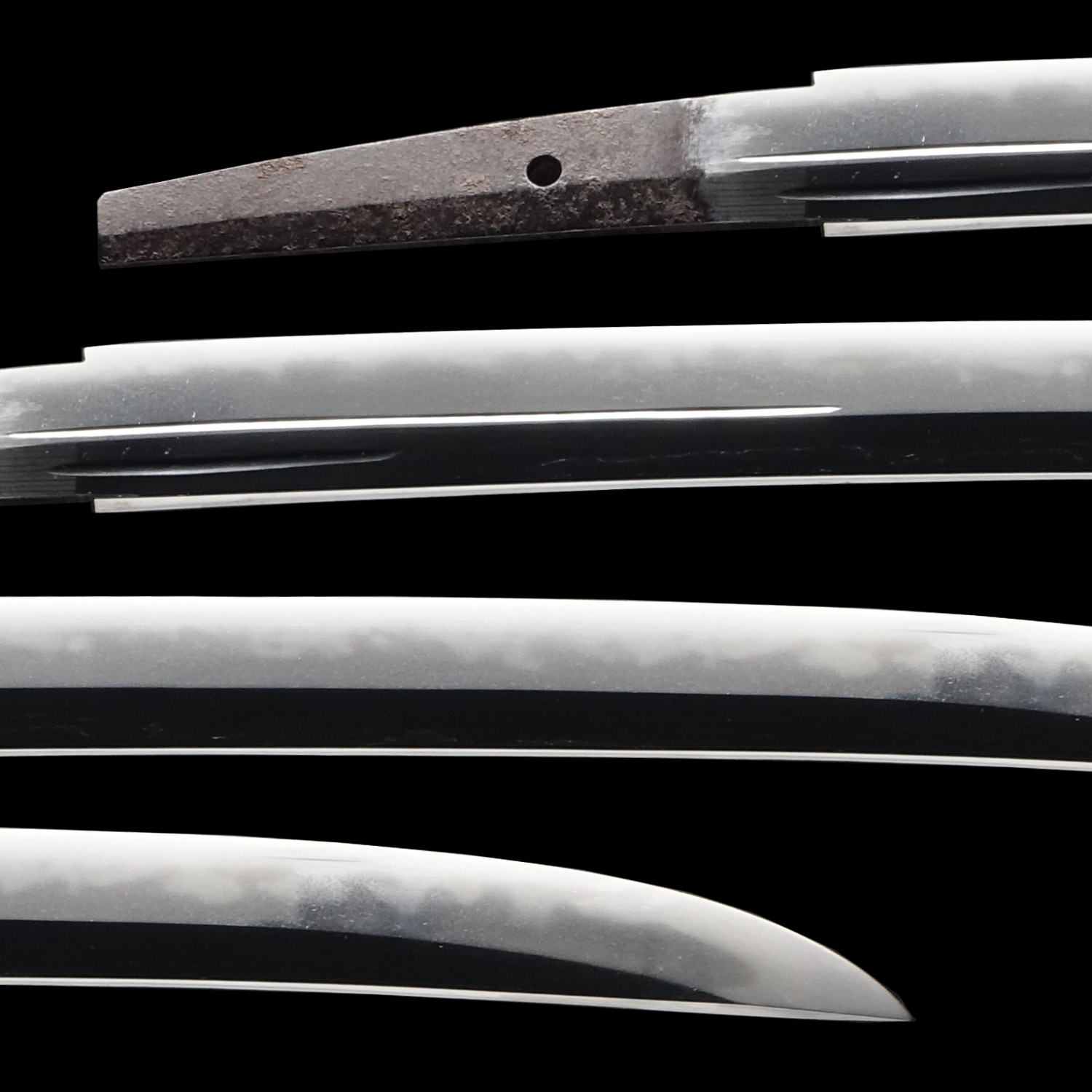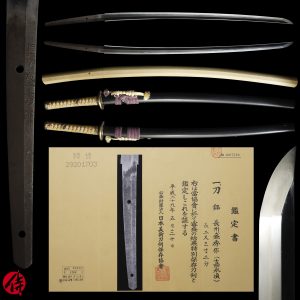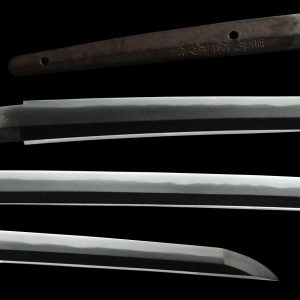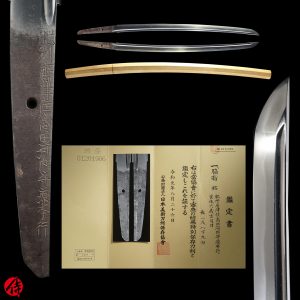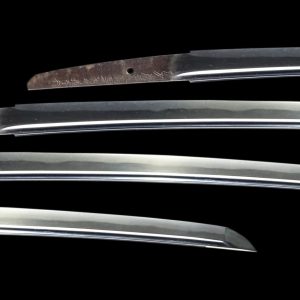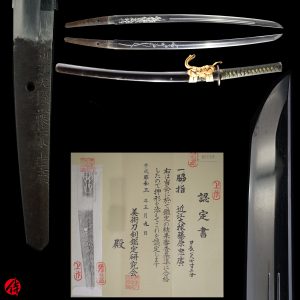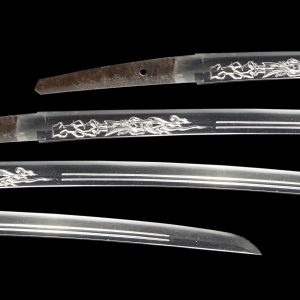Antique Japanese Sword Wakizashi attributed to Kashu Kiyomitsu with NTHK Kanteisho Certificate
【Description】
This blade is attributed to Kashu Chobei no Jo Kiyomitsu (加州長兵衛尉清光) , who was active during the Genroku era (1688-1704), according to its NTHK appraisal. It is said that the swordsmith’s name Kiyomitsu lasted 12 generations from the mid-Muromachi period to the end of the Edo period (1444-1868). Kiyomitsu is one of the most famous maker’s names in the Kaga domain (today’s Ishikawa prefecture) and belonged to Fujishima school. The attribution was given to a late-gen Kiyomitsu. The founder of Fujishima school was Fujishima Tomoshige (藤島友重), a student of Rai Kunitoshi, one of the most famous swordsmiths in Japanese history. It is believed that the first-gen Kiyomitsu was a descendant of Tomishige.
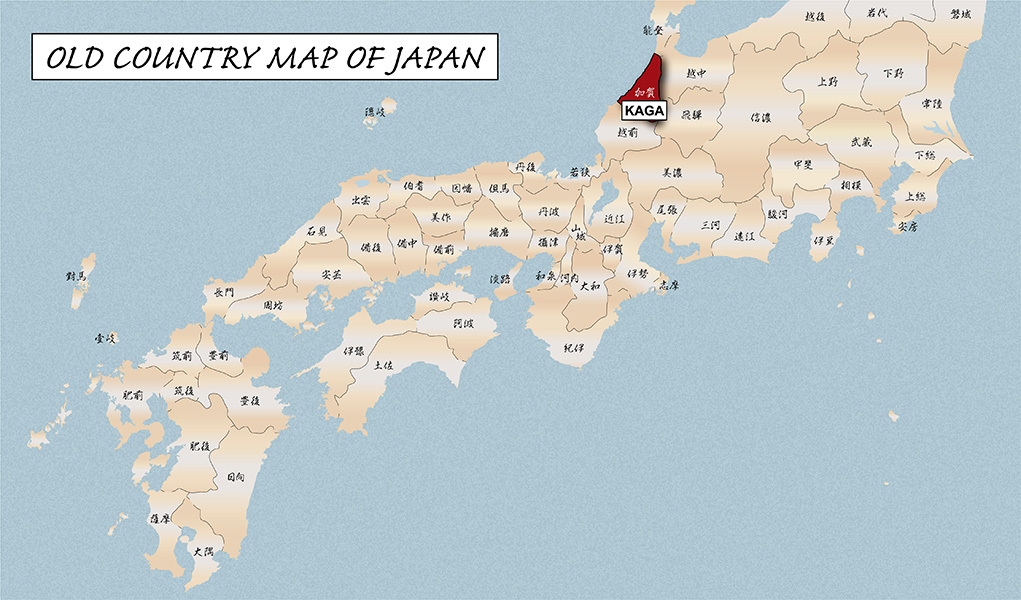
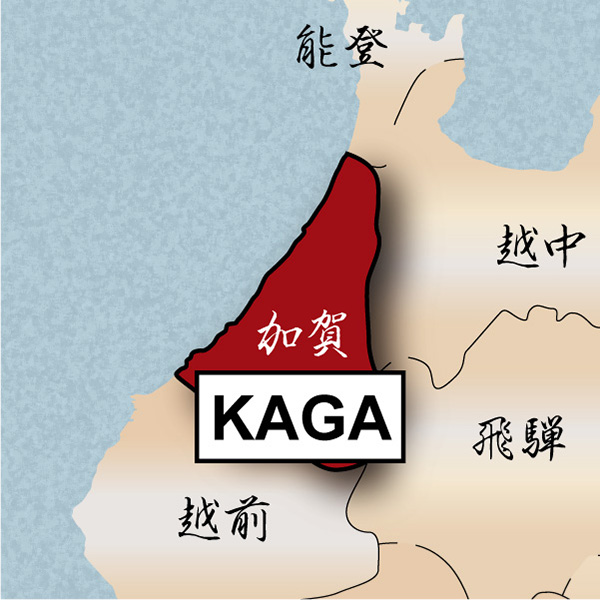
Kaga domain was ruled by Maeda clan when Kiyomitsu was alive. Maeda clan was originally a retainer of Oda family, who ruled Owari province. (today’s Nagoya area in Aichi prefecture) The first head of the Maeda clan was Toshie Maeda. He climbed the social ladder of Samurai society, and he became the feudal lord of Kaga Province(today’s Ishikawa prefecture). It is said that Toshie had a vast rice fief that fed 100 million grown-up adults, which is called Hyakuman Goku. The Maeda clan was one of the most influential clans in Samurai history. Toshie Maeda had a close tie with Oda Nobunaga and Hideyoshi Toyotomi. The generations of Kiyomitsu served Maeda clan and must have forged many swords for this clan. We also assume the high level of craftsmanship Kiyomitsu mastered was appreciated in the Kaga domain.
*Please keep in mind that there are a few noticeable Kitae Kizu on this blade. If you like see the detailed condition, please check other photos.
【 Blade】
Cutting Edge Length(Nagasa): 52.1 cm (20.5 inches)
Curvature(Sori): 0.45 cm ( 0.17 inches)

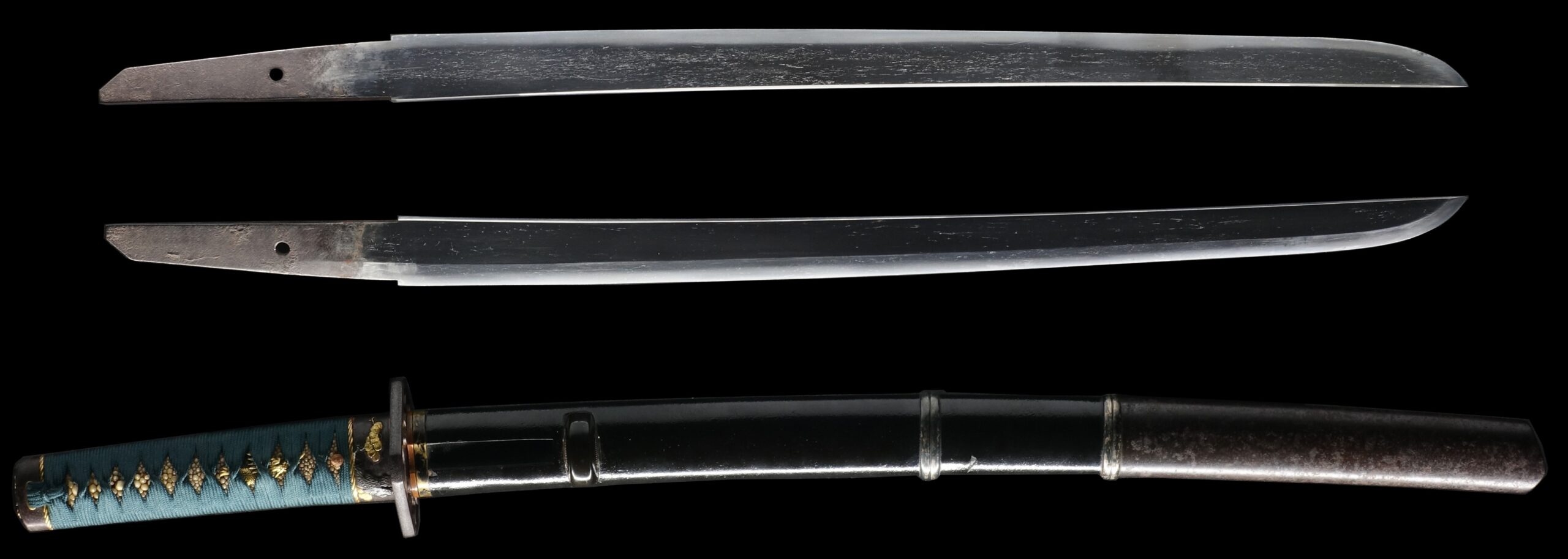
Hamon:
The crystalline structure which forms along the cutting edge of a blade as a result of the hardening process
Jimon(Jihada):
visible steel surface pattern created by folding and hammering during forging process
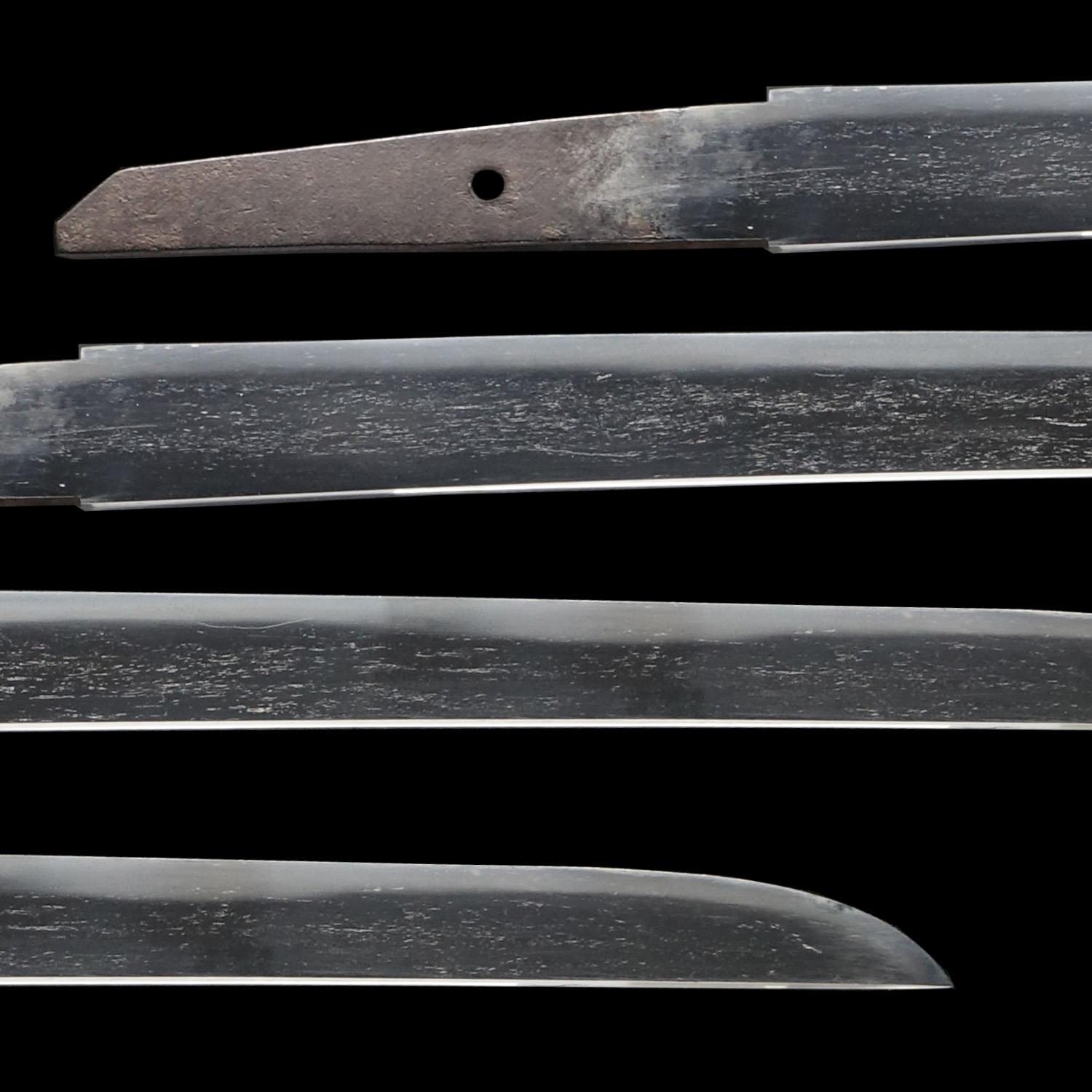

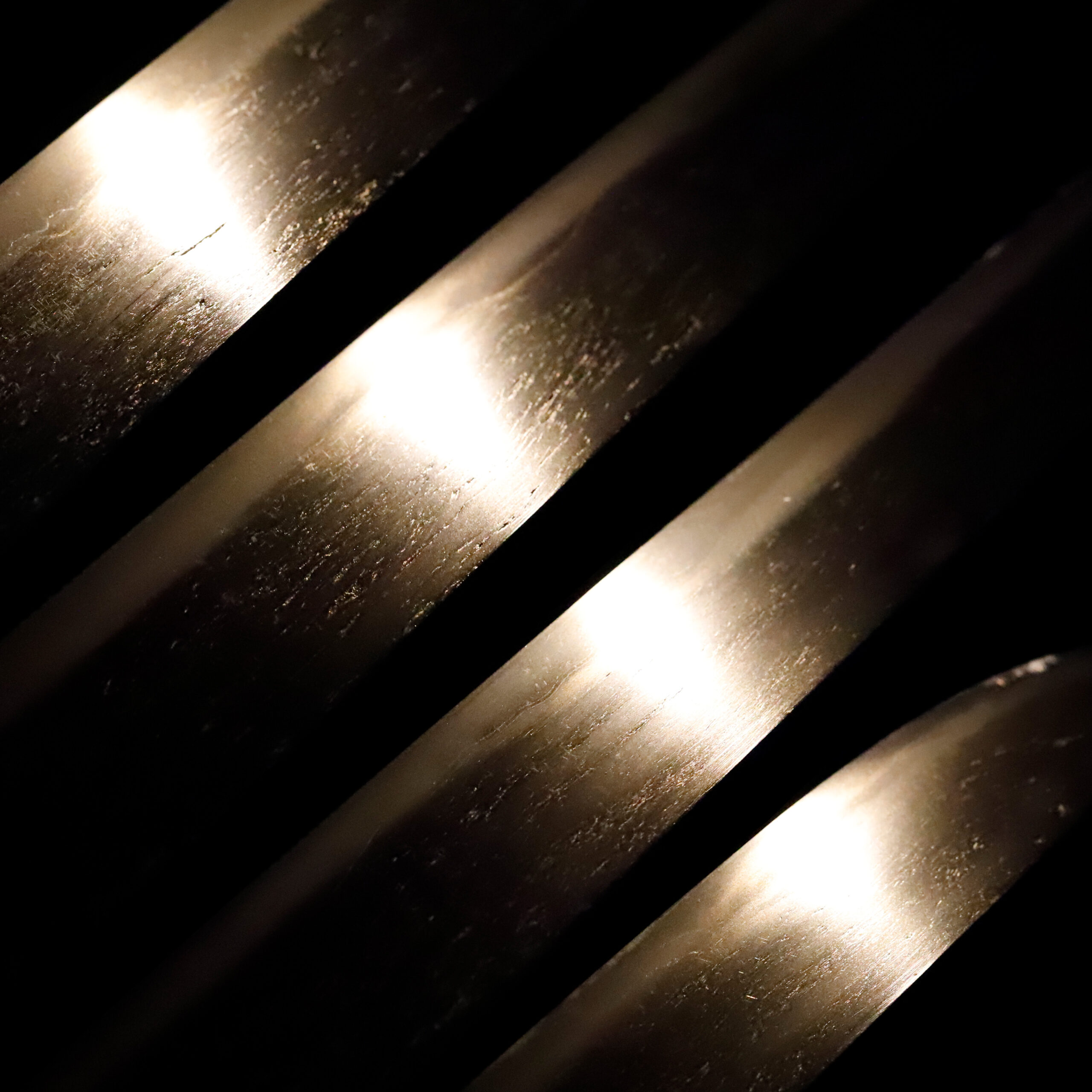
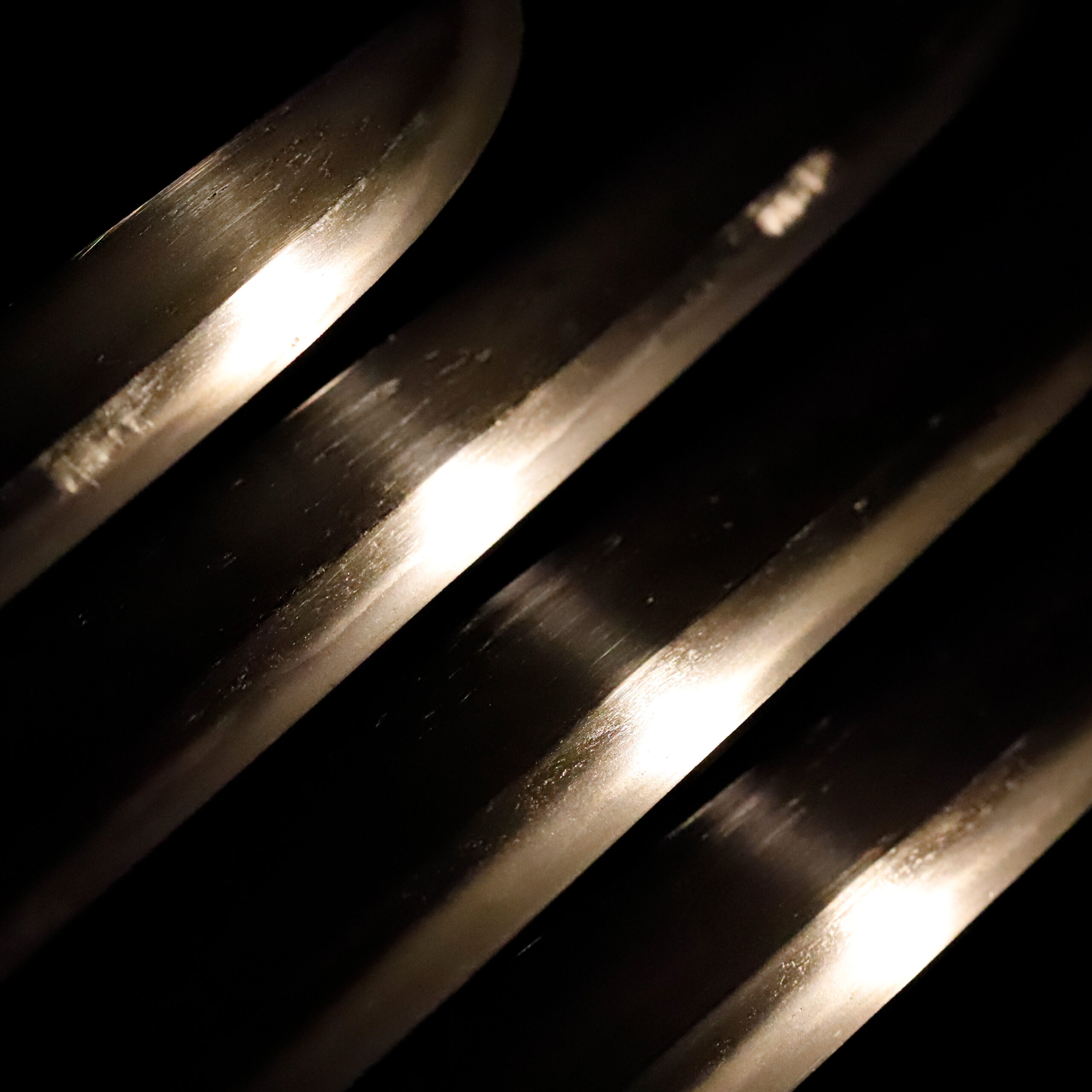
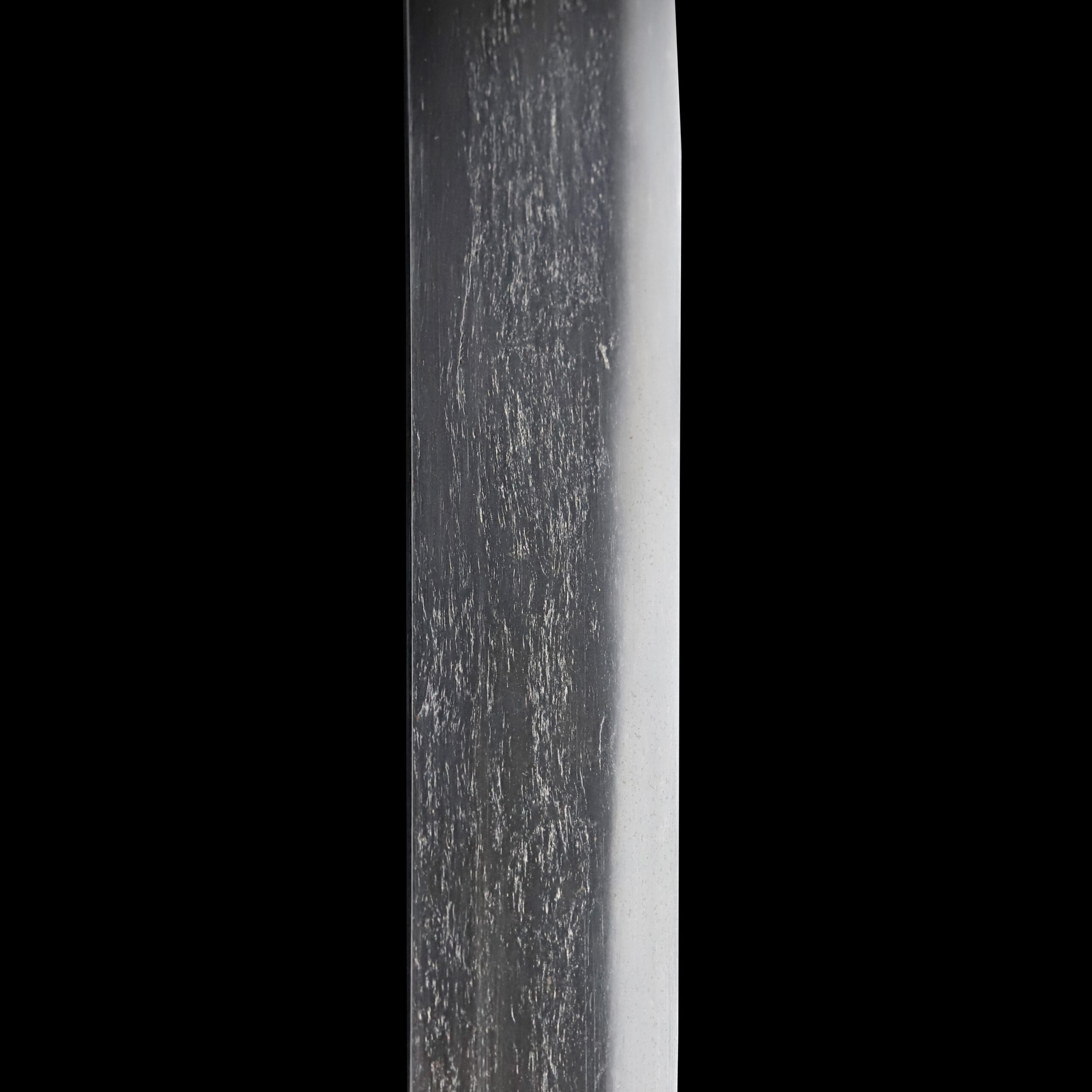
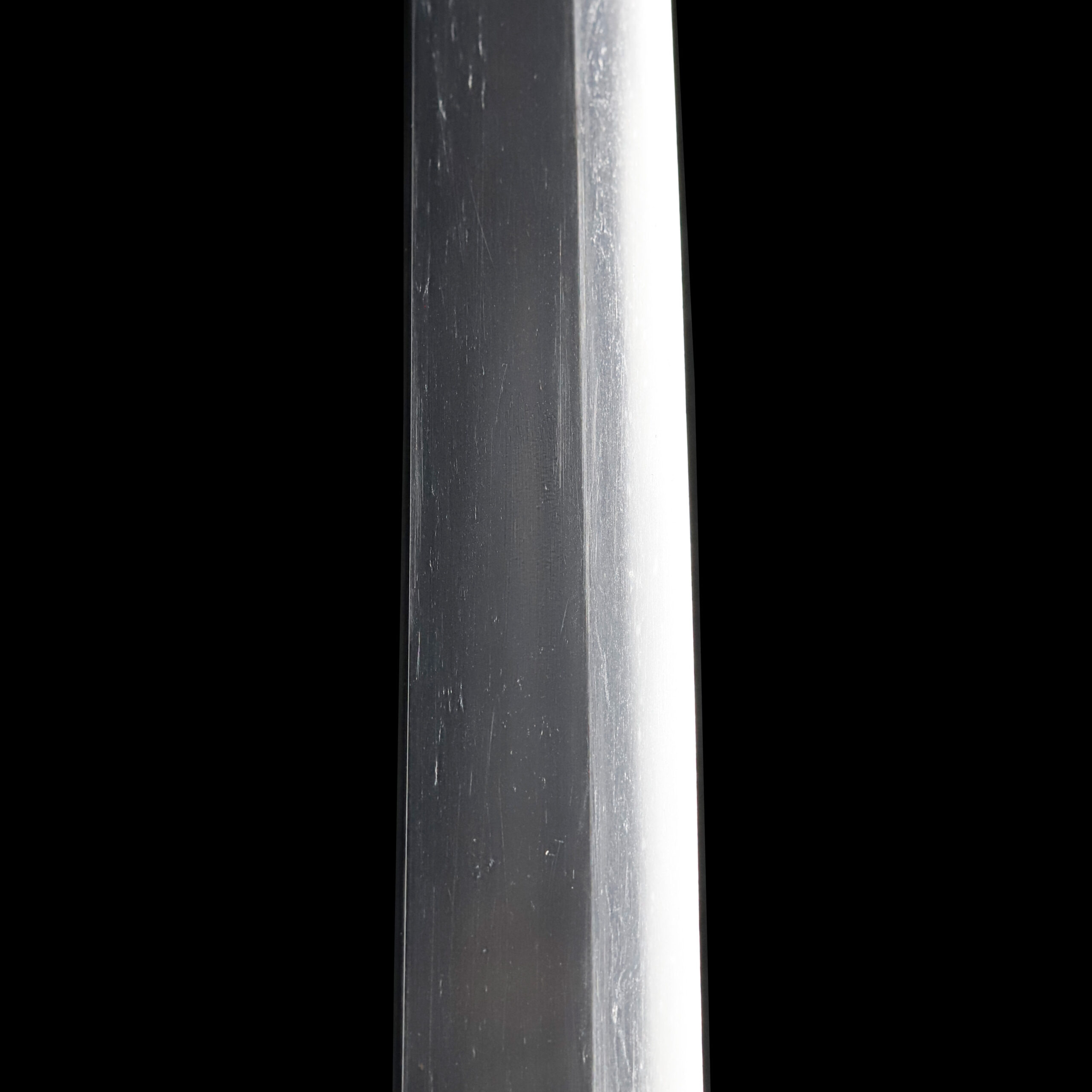
Nakago:Nakago is the tang of the Japanese sword.
Japanese swordsmiths left the black rust on the tang because it prevents red rust while the tang is in its handle. And the discoloration of the tang was created over time, and it is a great indicator for a Japanese sword specialist to estimate when the sword was forged.
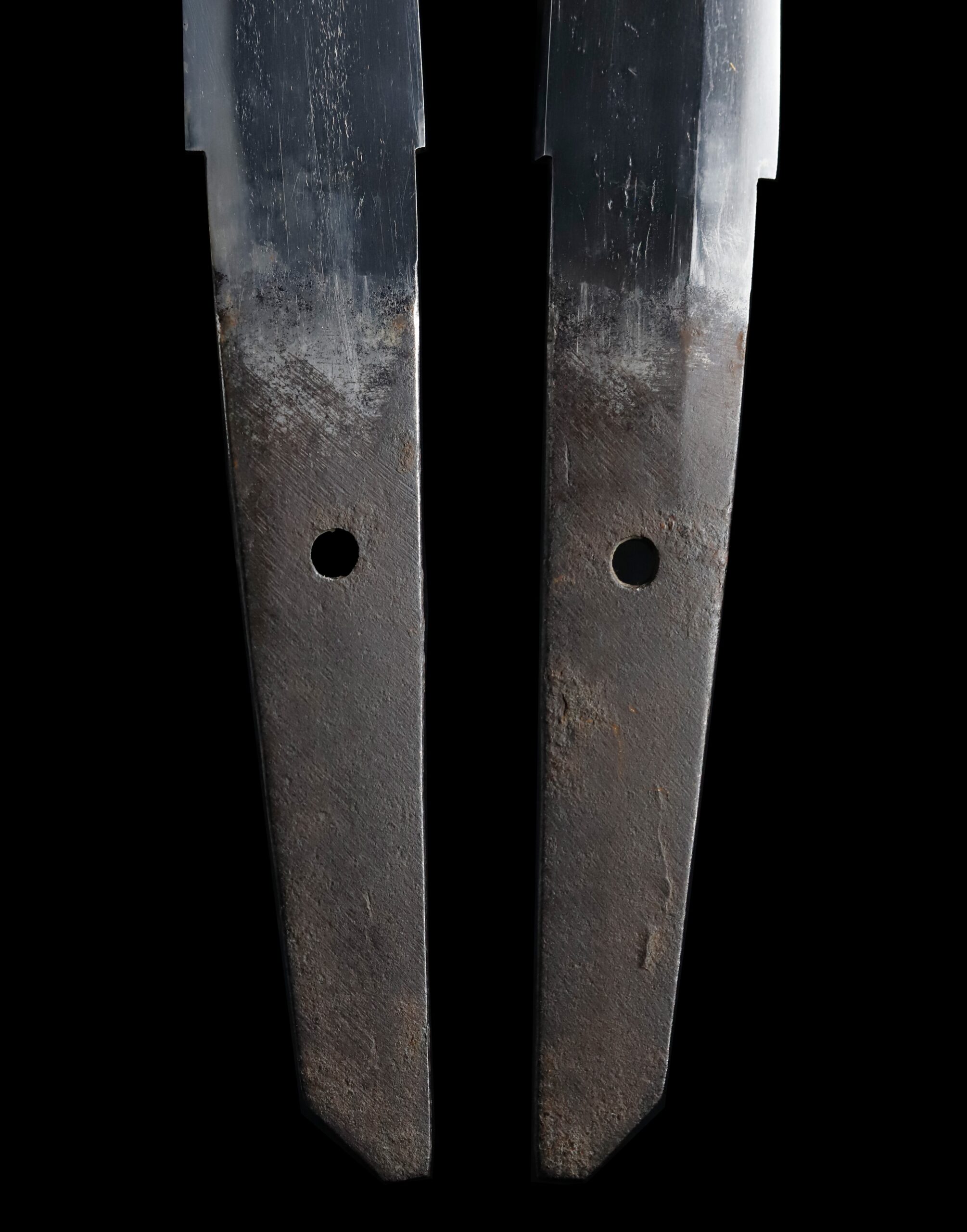
Koshirae: Koshirae is the mounting of the Japanese sword. There are several parts that consist of Koshirae such as Saya(Scabbard), Tsuka(Handle), Tsuba(Handguard).
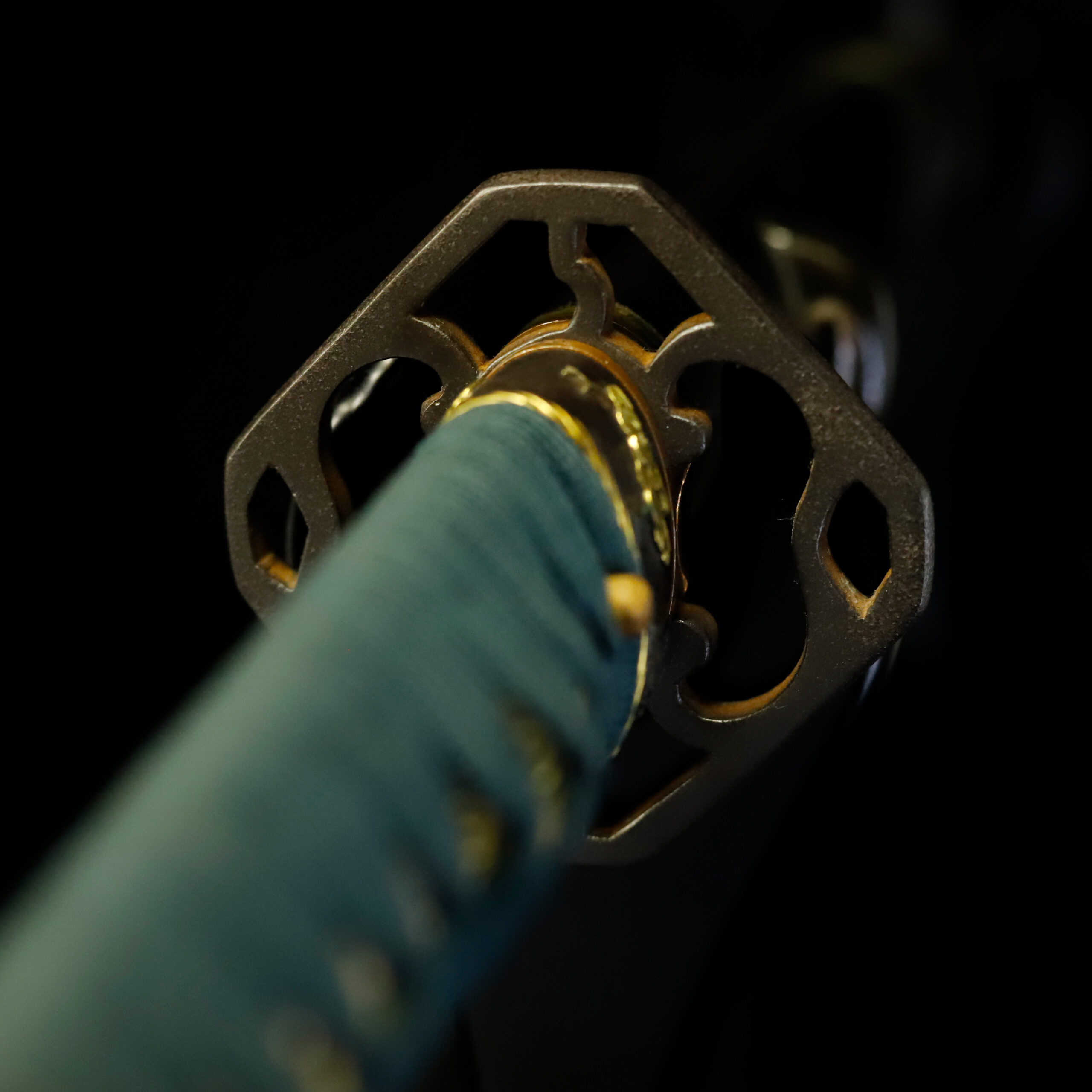
Fuchi-Kashira:A pair of matching sword fittings that cover the upper and bottom parts of its sword hilt.
A combination of bird and pine trees is exquisitely arranged in this Fuchi Kashira. We estimate this bird is the Taka (鷹, hawks/falcon) or Washi (鷲, eagle). It is challenging to judge which is the motif in this work because they have similar looks. Since hawks build their nests in pine trees, we would like to conclude that this combines pine trees and hawks. This theme is called the Matsu Taka Zu (松鷹図). The strength of hawks has made it a symbol of power, and both Samurai families and court nobles have appreciated this design. It is also a symbol of bravery and grace, and the valiant appearance of hawks fascinated people.
Falcons are intelligent birds used for hunting, called falconry. It was famous as a recreation among high-class Samurai. In the old days, it was also familiar with emperors and royal families, so it might be why the hawks were regarded as a symbol of the ruler’s authority. During the warring period, the boy’s success was to become an excellent Samurai; therefore, it has been thought that men (Samurai) and hawks had a deep connection as a symbol of advancement and authority.
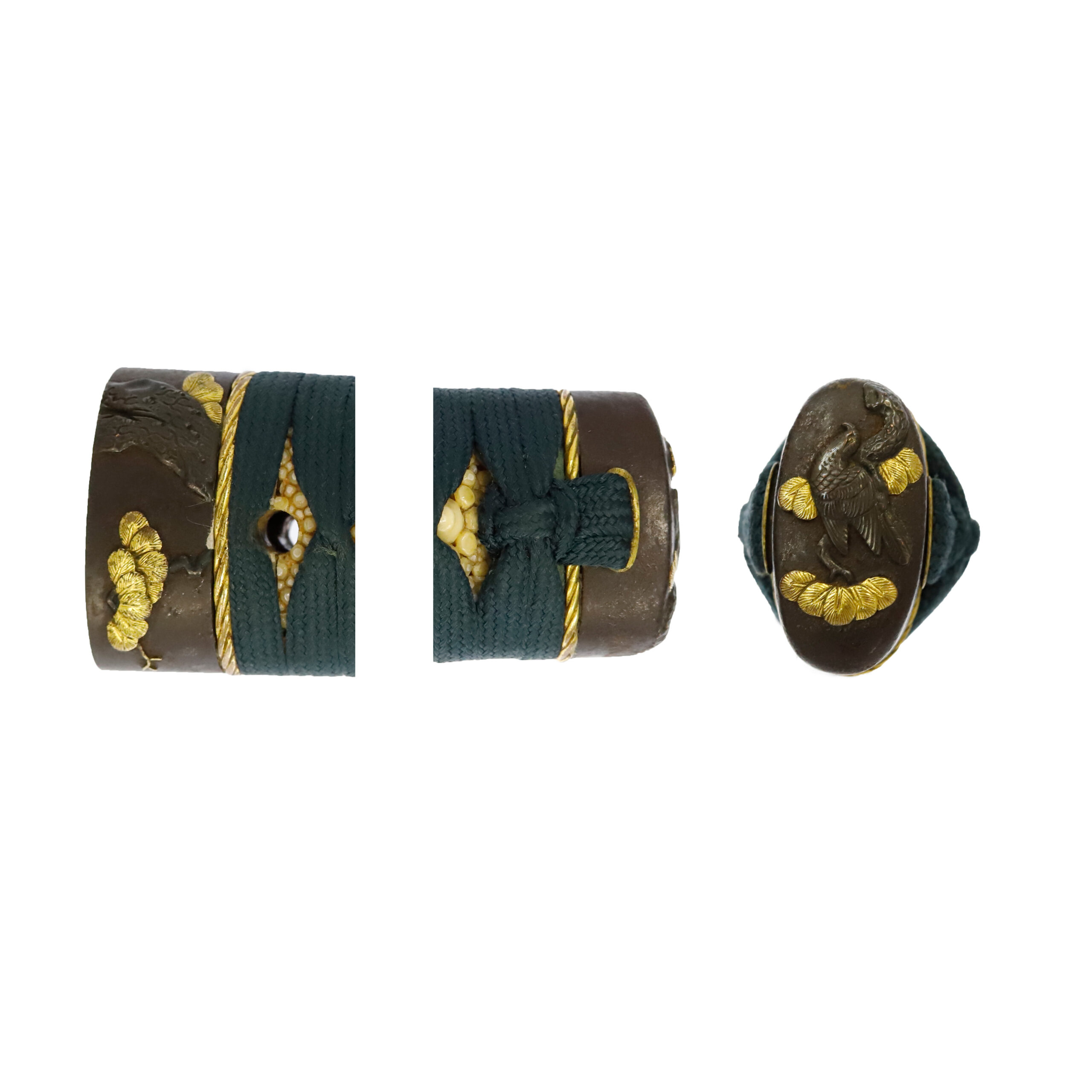
Tsuka and Menuki:Tsuka is the handle of the Japanese sword and Menuki is its decoration.
You could see the figure of the animal on each side of the handle. This animal has a dragon head and a fish body. Based on this appearance, we assume the motif of this Menuki is a dragon or a Shachihoko (しゃちほこ). The Shachihoko is a decoration used for the roofs of castle towers and watchtowers. The Shachi (鯱) is an imaginary creature, and it is said it has a dragon or tiger’s head and its body is a fish. Its tail bends toward the sky, and people associate its figure with the Hoko (鉾, an ancient form of Japanese long weapon). That is why this animal was named the Shachihoko. According to a theory, the Shachihoko would spit water out of its mouth when a building catches fire. Therefore, it has been put on the roofs of many castles and temples in Japan.
Initially, the dragon was an imaginary creature found in ancient foreign traditions and myths. Furthermore, it is regarded as a symbol of auspicious signs. Its body is likened to nine animals: antlers are deer, the head is a camel, eyes are demons, the neck is a snake, the belly is the Mizuchi (蛟, a mythical animal in Japan that looks like a snake and has a horn and four legs), scales are fish, claws are falcons, palms are tigers and ears are cows. It was thought that the dragon would reign at the top of all animals because of its odd-looking appearance. There are lots of dragon-designed sword mountings. It shows that many Samurai warriors have cherished the dignified beast motif.
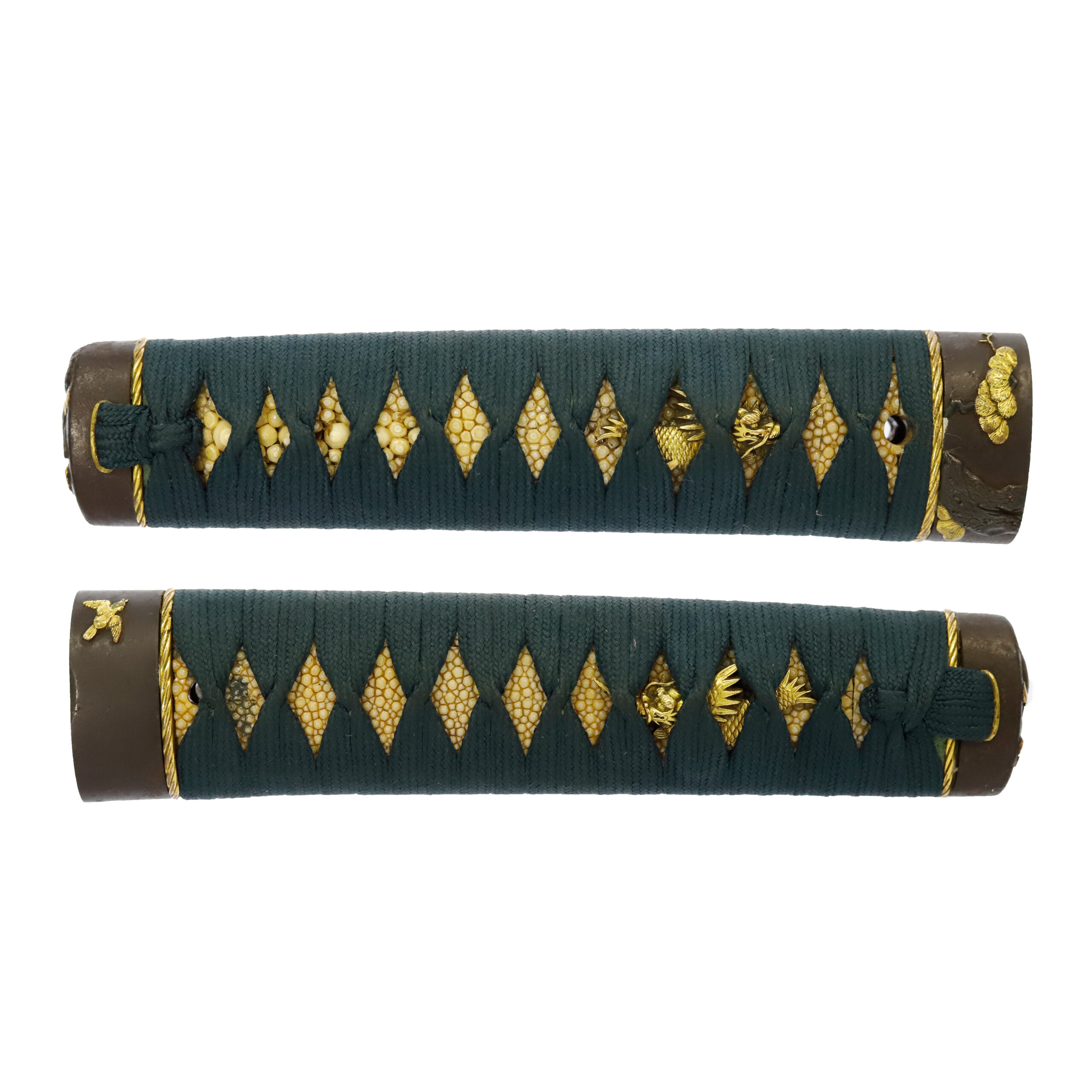

Tsuba and Habaki:Tsuba is the handguard for the Japanese Sword and Habaki is the equipment to make the blade not touch its scabbard inside. It prevents the blade from getting rusty and chipped.
This antique iron Tsuba has a symmetrical design. While we are unsure about the specific motif is unknown, the geometric patterns are elegantly carved with openwork. When you look at the entire appearance of this Wakizashi’s Koshirae, you would enjoy the matching of this Tsuba’s look matches well with other sword mountings.

Kozuka:Kozuka is a small knife stored in Kozuka Hitsu(groove of the sheath of the Japanese sword).
A Kogatana (小刀, small knife) is stored in the Kozuka. The surface of this Kozuka is decorated with the Nanako-Ji (魚子地) technique. This process makes a uniform minimal protrusions pattern by hitting the Nanako-Ji Tagane (魚子地鏨, a chisel for this technique) on a metal surface. This decorative technique is often seen on sword mountings.
We estimate the engraved motifs on this Kozuka are probably turtles. While most colorings have already faded due to aging, there are traces of golden paint was initially applied to them. There is a saying that a crane lives for a thousand years, and a turtle lives for ten thousand years. Based on this idea, there are people who treat turtles as auspicious animal that represents longevity.
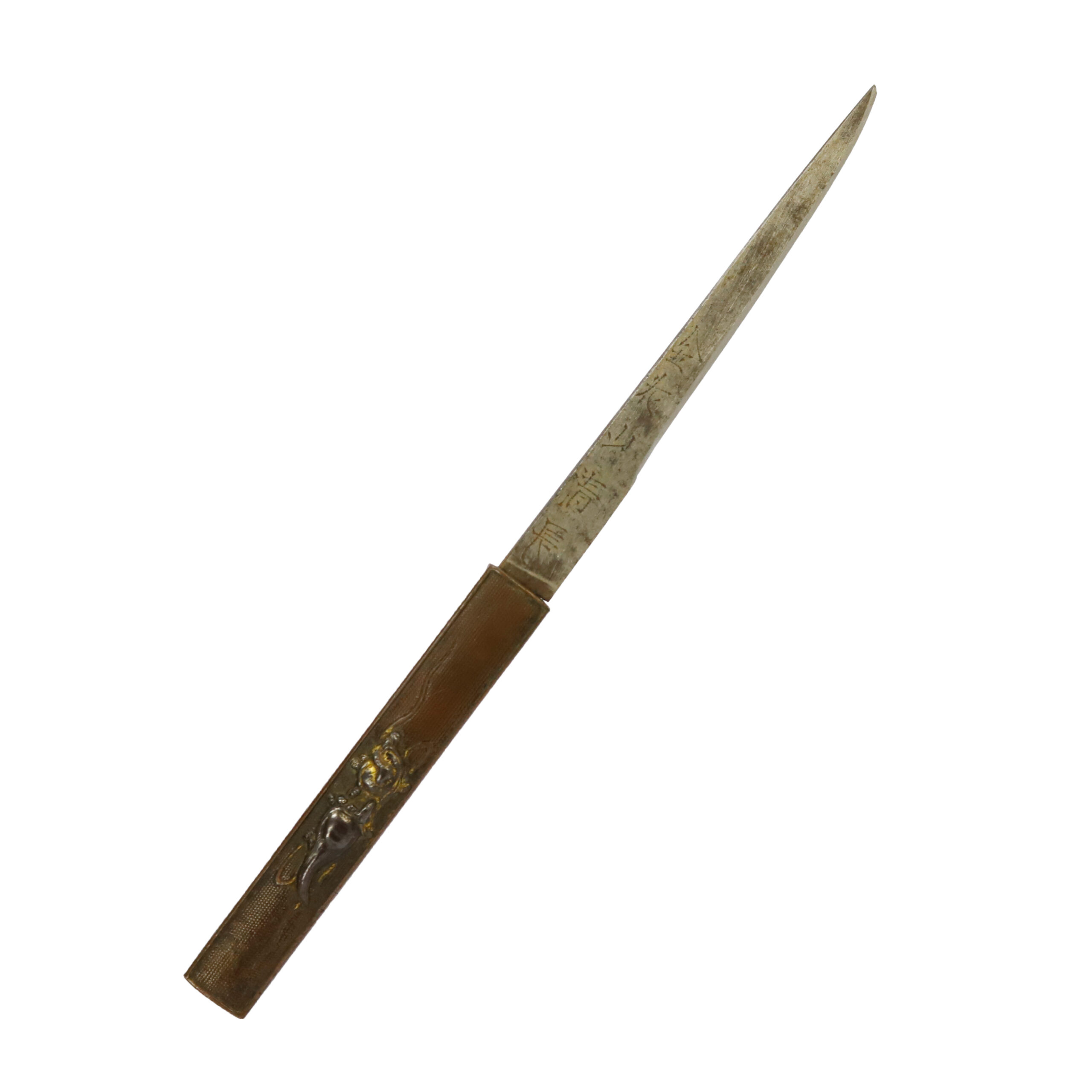
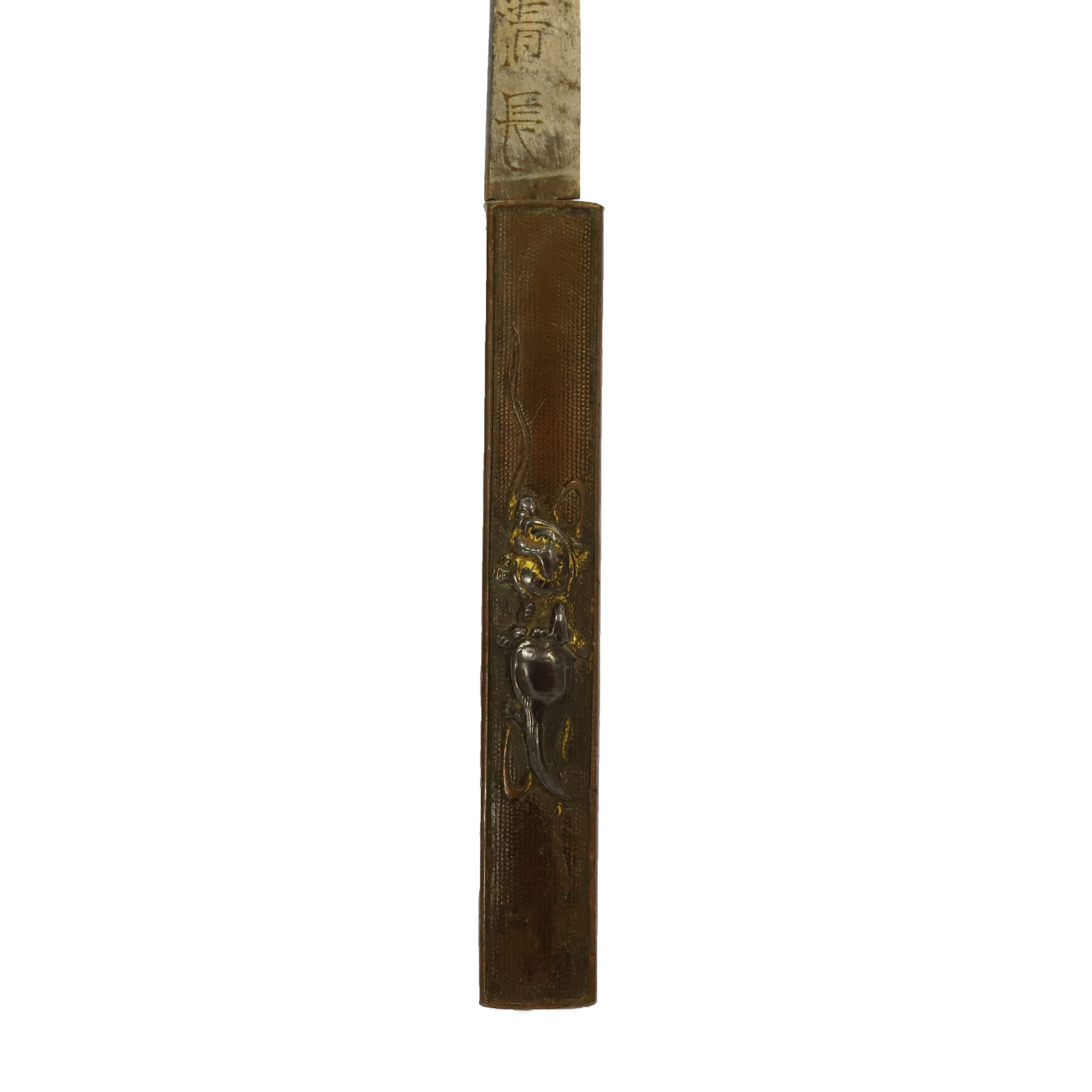
Saya: Saya is the scabbard for the Japanese sword.
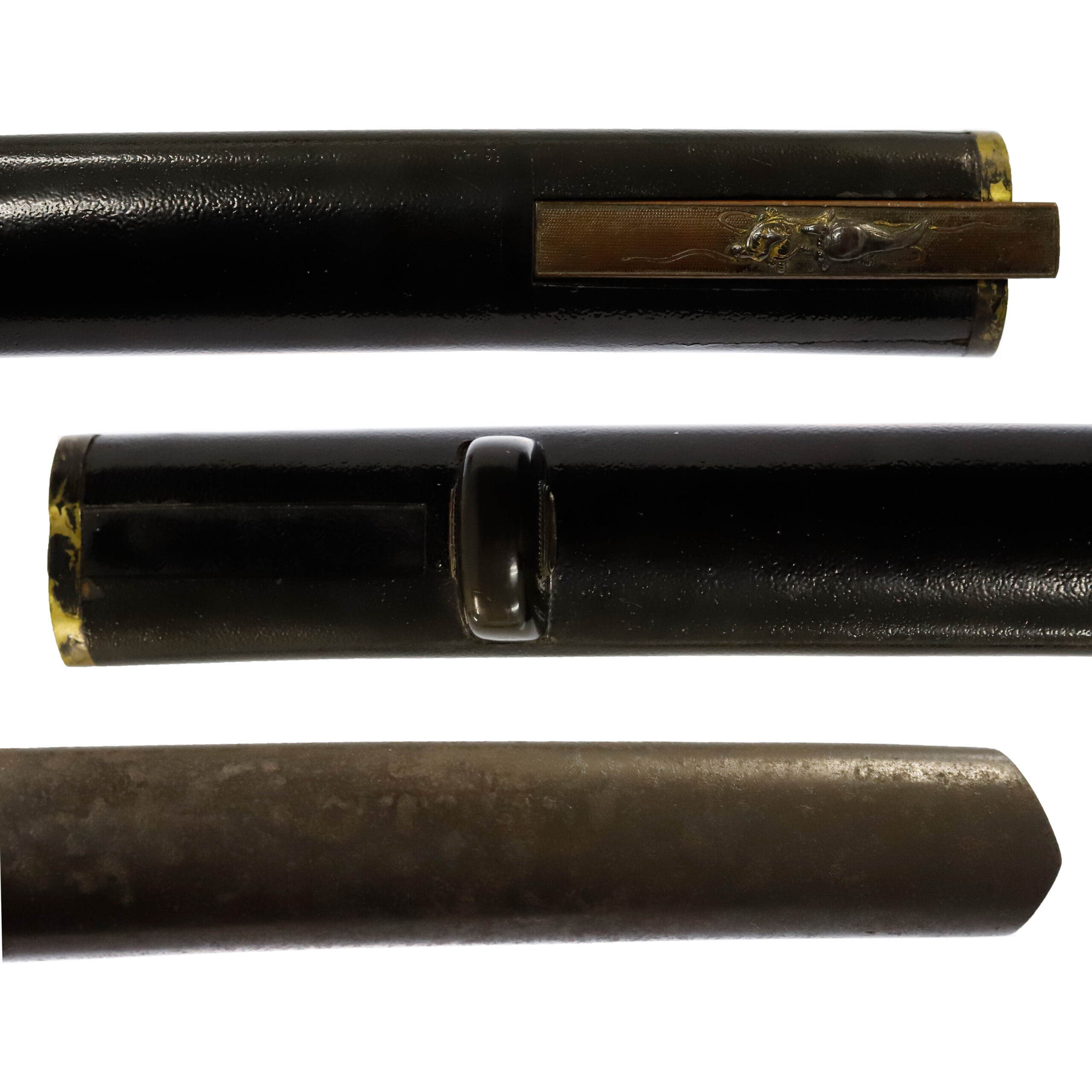
Authentication Paper:NTHK Kanteisho Certificate for the blade
NTHK, also known as NPO Nihon Touken Hozon Kai, is the oldest organization for sword authentication of Japanese swords in modern times. It was established in 1889 during the post-Samurai era. They authenticated the blade on Feb 14th in the 3trd year of Reiwa (2021). The purchaser will receive this original certificate as well. We can also translate what is written into English and make a PDF file for your record if you request.

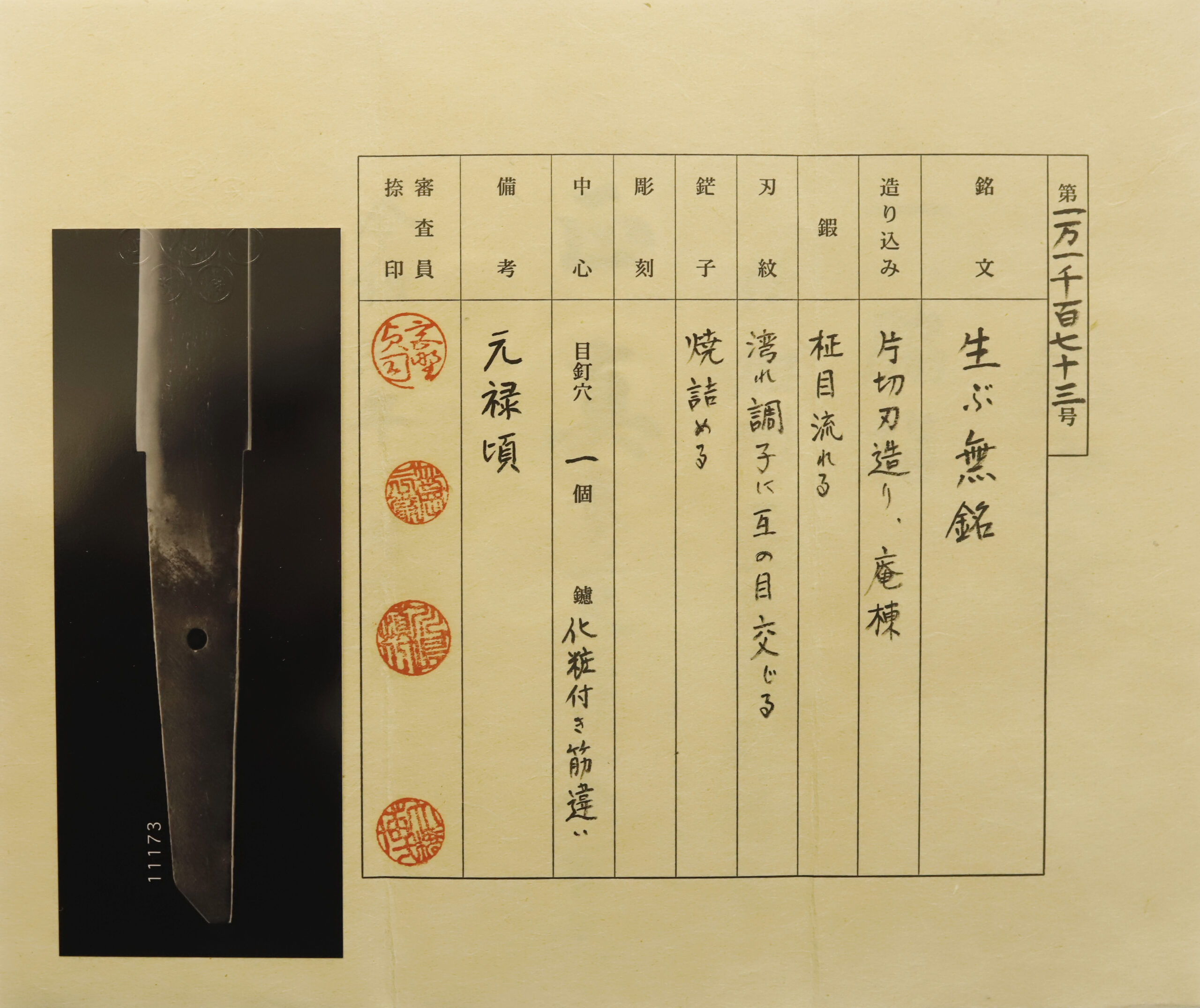
Registration Number : Nagano 4431
The Board of Education in Nagano prefecture issued a registration paper for this sword . It is called Jyu Token Rui Torokusho(銃刀剣類登録証). Bunkacho(The Agency for Cultural Affairs) acknowledges a Japanese sword with this paper as a work of art.
The sword needs to be traditionally hand-forged and made of Tamahagane carbon steel to be registered in the system. With this paper, its owner in Japan can legally own an authentic Japanese sword. Based on this registration number, we will apply for its export permit.
This paper will need to be returned to the board of education when the sword is being shipped abroad, but you can receive a copy of it. An English translation of this registration paper is available on request.
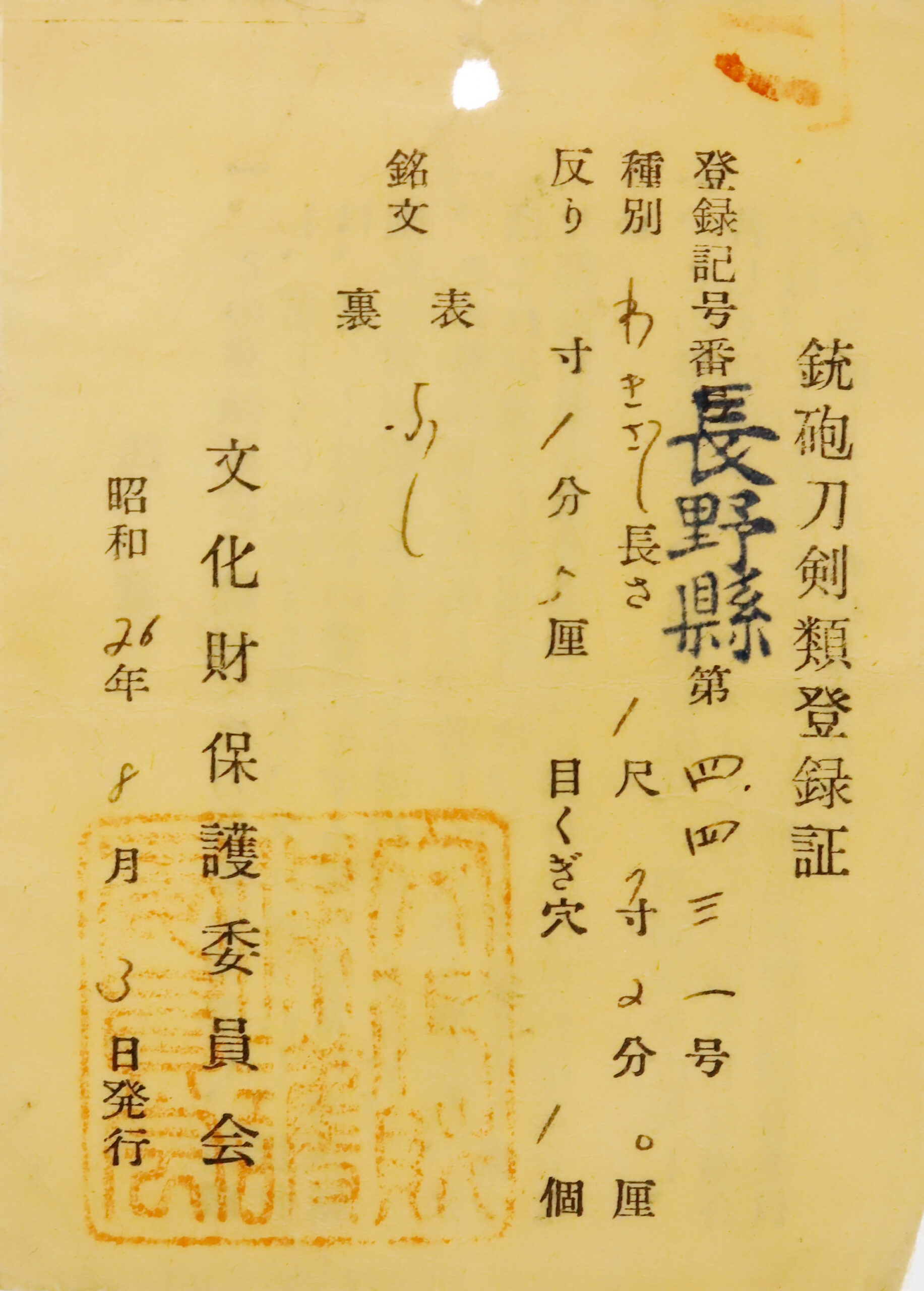
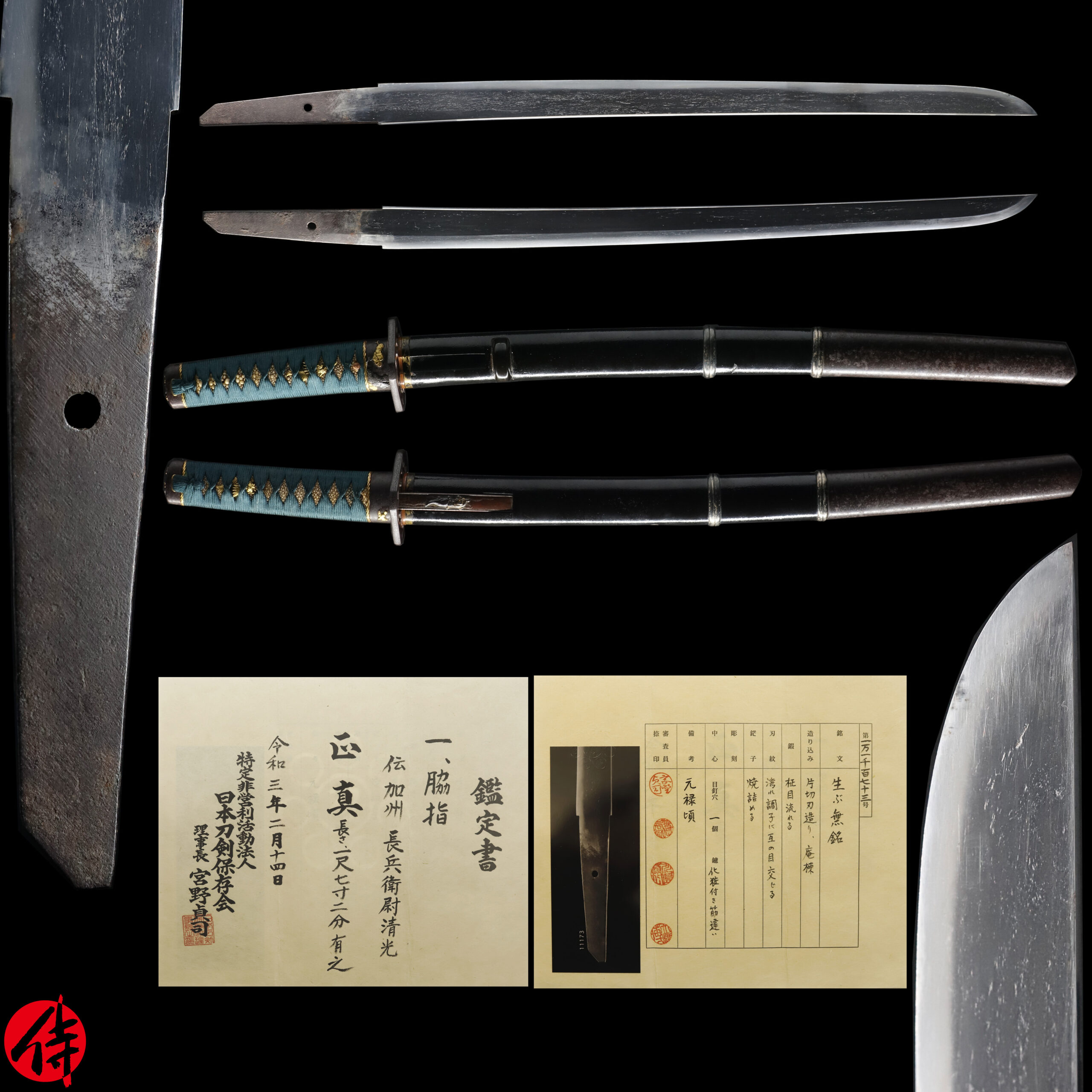
—————————————————————–
【About us】
Samurai Museum is located in Tokyo, Japan, exhibiting antique artifacts related to the Samurai history. Samurai Museum Shop is the place for those who are interested in Japanese culture and craftsmanship. We deal with antique Samurai swords/armor, traditional crafts made in Japan and so on.
【Japanese Sword& Export Process】
The Japanese swords we deal with are hand-forged edged swords made in Japan. It was made from the traditional carbon steel called TAMAHAGANE(玉鋼). Samurai Museum is familiar with the proper legal procedure for an antique/ authentic Japanese sword to be exported from Japan. We have sent more than 700 Japanese swords for the past few years (~2024) to amazing owners who appreciate its historical value.
Each Japanese sword is registered under the Agency for Cultural Affairs and the Board of Education in Japan. They issue a registration paper for each Japanese sword for its owner in Japan to legally possess it. The Japanese sword with its registration paper means it was traditionally hand-forged in Japan.
To legally export the sword from Japan to other countries, we will have to apply for its permit to the Agency for Cultural Affairs(Bunkacho) and return the original registration paper to the Board of Education. It normally takes around 2-4 weeks to receive this permit after submitting required documents. And we would like you to expect at least 1-1.5 months for your order to arrive at your given address after you ordered. For more detailed info, please click here.
It is allowed for residents in Japan to own authentic Japanese swords without a special license as long as they come with registration papers. Please feel free to contact us if you are a resident of Japan, whether temporarily or permanently. We will also assist you when you leave Japan and need to obtain the export permit.
【Payment Method】
We accept payment through Stripe (Credit card), PayPal, Apple Pay or ChromePay, all of which are secure payment methods. Also, you don’t need to make an account on Stripe for the checkout. If you prefer other payment method, please contact us. After confirming your payment, we will apply for an export permit. You may either pay in JPY, USD, AUD, CAD,EUR CHF or GBP. The price is set in Japanese Yen. Prices in other currencies are automatically calculated based on the latest exchange rate.

* If the amount is above 1 million JPY, Stripe or wire transfer will be the only options for payment.
【Shipping】
We have shipped authentic Japanese swords to the USA, UK, Canada, Mexico, Germany, France, Hong Kong, Finland and Australia. If you don’t live in these countries and like to order, please contact us first before making a purchase. We offer Free International Shipping as long as we can send antique Japanese swords by EMS.
We normally ship by EMS(Express Mail Service) provided by Japan Post. We will send you a tracking number for your order as soon as we hand it to the post office. We will put 100 % insurance on the shipping document without any extra charge. Based on the total amount, there might be a duty tax or other fee for you to pay, depending on the countries. We use package cushioning to protect the item and put it in a PVC pipe, which is one of the most secure packages because of its durability.
It will normally takes 5-14 days for the item to arrive at your given address after we dispatch it. Time of delivery is estimated as accurately as possible by the carrier but does not take into account any delays beyond our control such as by inclement weather, post office holiday seasons.
* If you live in Australia and like to purchase an authentic Japanese sword, please click here to know the detail.

【Review】
Here is one of the reviews we received from a customer who purchased an authentic Japanese sword from us. For more reviews, please click here.
“My experience overall with the whole process was wonderful. I had many questions about the history and process to purchase these treasures. All my questions were answered very timely and complete. The staff is very knowledgeable and very well versed if any questions do arise.”
【How to make sure the condition】
Please keep in mind that what you are going to purchase is an antique item. We uploaded high resolution photos for you to check its condition thoroughly. If you like to see more photos with different angles, please feel free to contact us. We will be happy to send them to you so that you can make informed decision. It is essential for us to know that you are happy with your choice of a sword. and we are prepared to use the best of our ability to serve you.
【How To Contact Us】
Please contact us through email, Facebook Messenger or Live Chat if you have any questions. You can find each icon on the right side of the website. Please click one of them to reach us. We will reply to you within 1-2 business days.
【The Art of Nihonto (Japanese Sword)】
Samurai’s history is a profound, eloquent legacy of ancient Japanese warriors in which millions of people worldwide are being fascinated. If you like to find out the art of Nihonto, please click here.
【A Guide to Japanese Sword Maintenance】
After acquiring an genuine Japanese sword, it is also important to know how to take good care of it. Here is the special video for you. Mr. Paul Martin, Japanese sword expert, shows you how to give proper maintenance to your sword. By mastering how to clean the Japanese sword, its aesthetic beauty will last forever.
When you purchase a Japanese sword from us, you can get a Free Japanese sword maintenance kit. It comes with four tools(Choji Oil, Uchiko Whetstone Powder, Peg remover, Oil Applicator). By watching the video instruction above , you can enjoy learning how to maintain your Japanese sword while appreciating it. If you have any difficulty assembling the sword or cleaning the blade, you can feel free to contact us.


MORE ANTIQUE JAPANESE SWORD FOR SALE
SWORDS WITHOUT CERTIFICATES FOR SALE
LEARN JAPANESE SWORD TERMINOLOGY
Thank you for reading all the information on the page. If you have any difficulty choosing the right Japanese sword for you, we will be more than happy to help you find the one that speaks to you the most. Please feel free to contact us.
